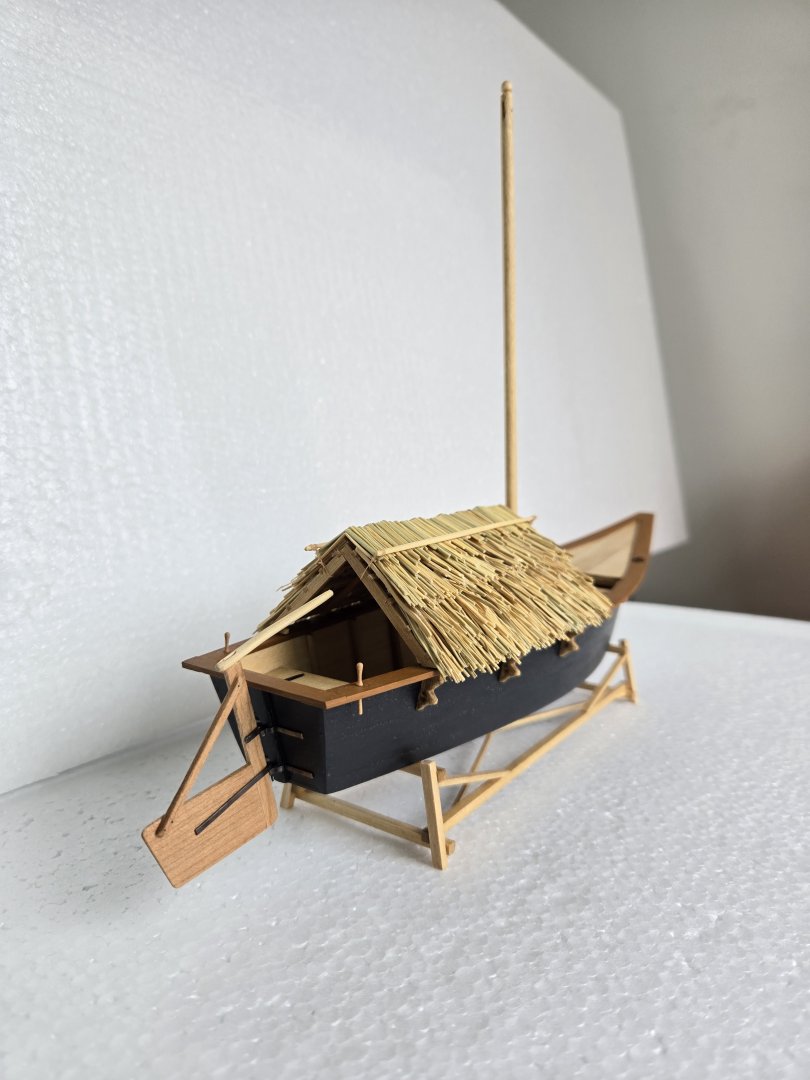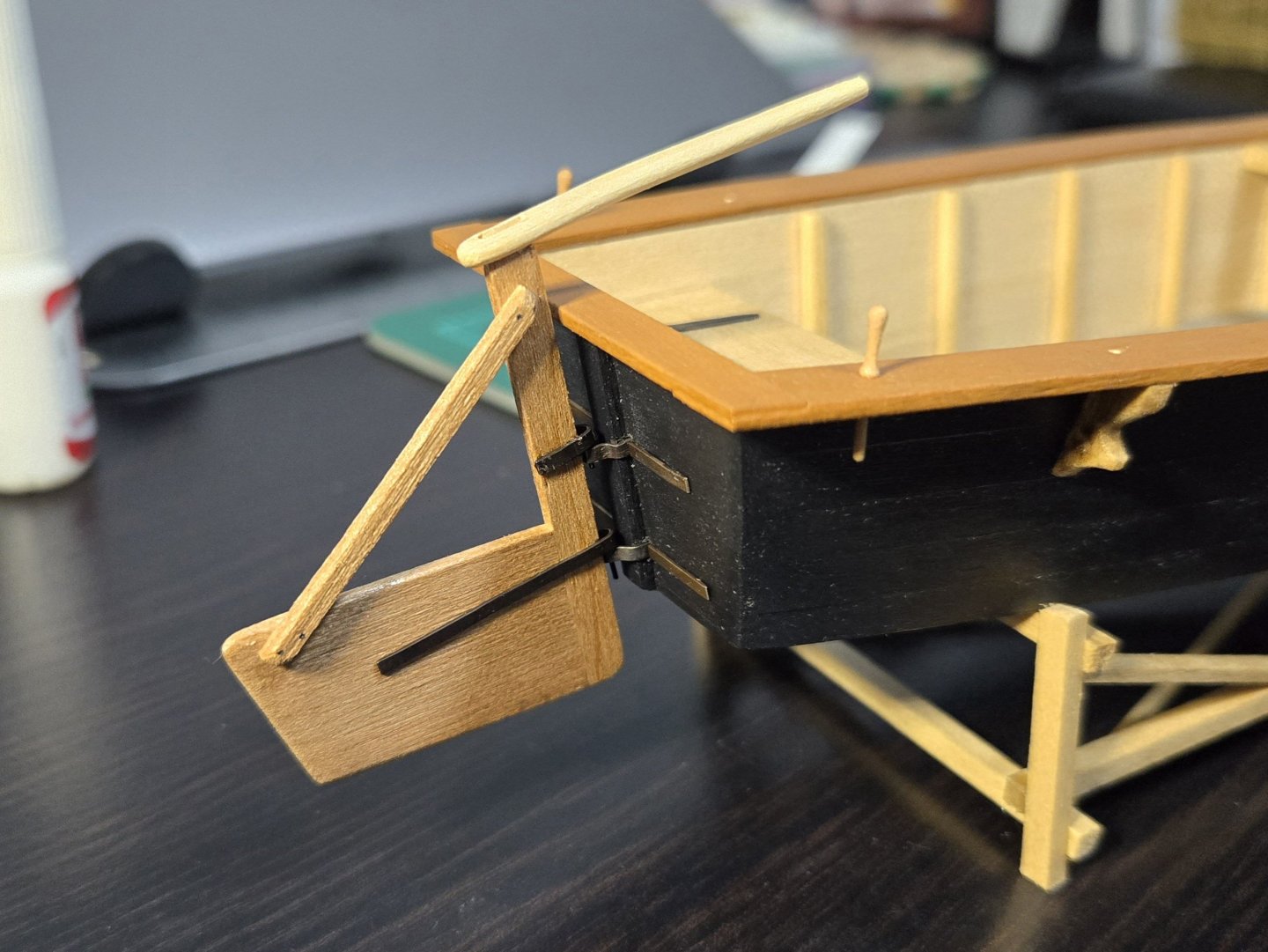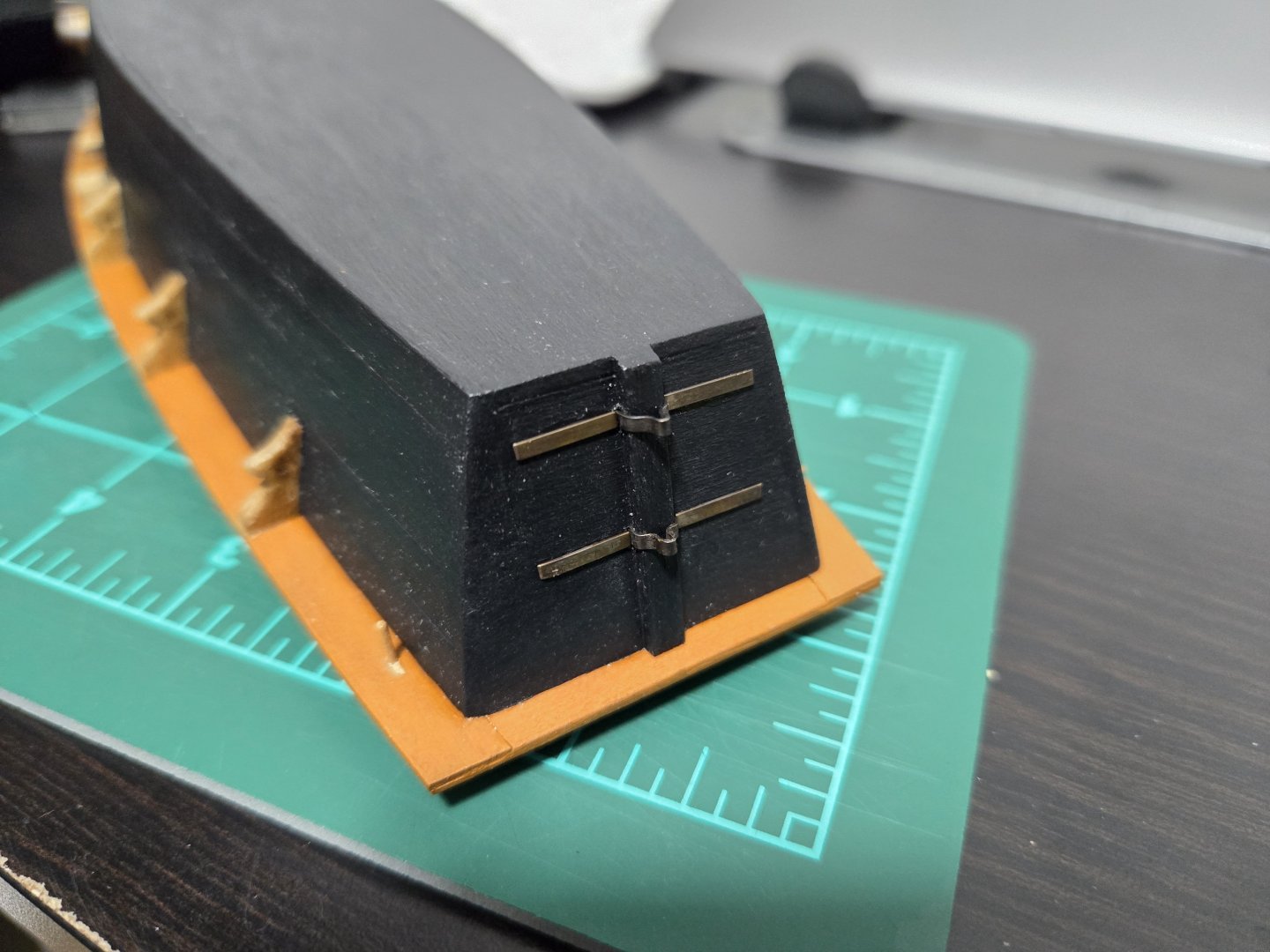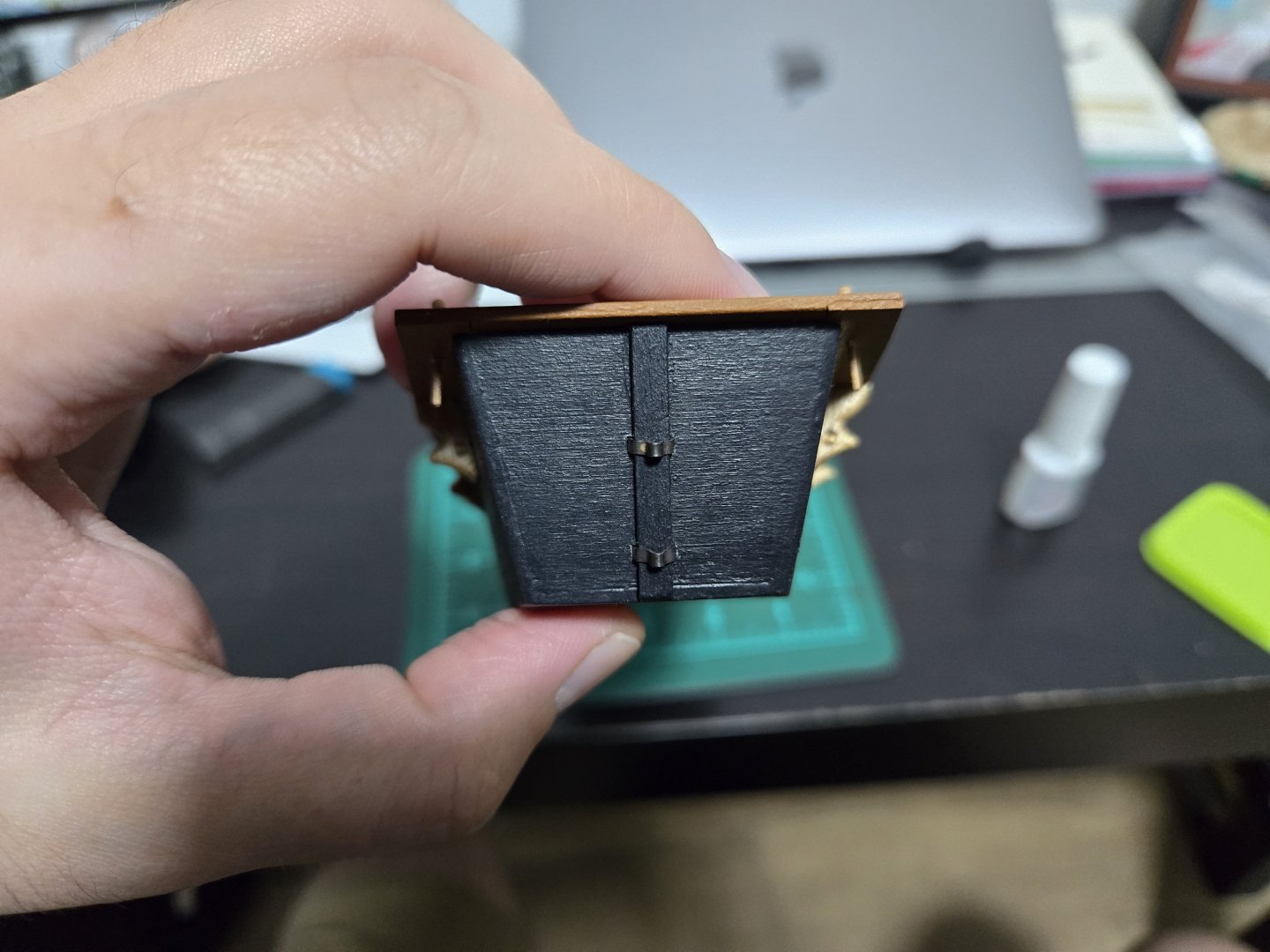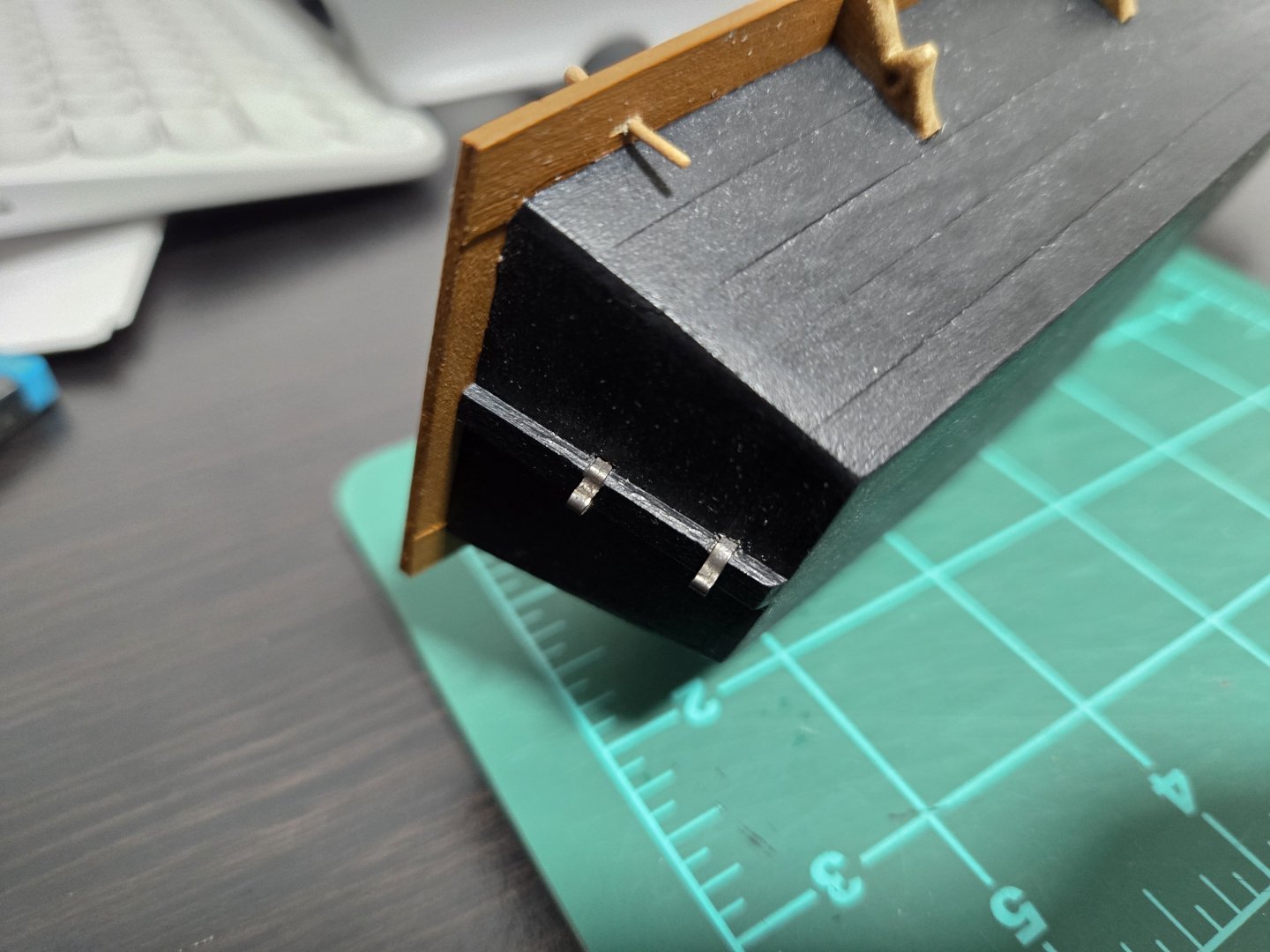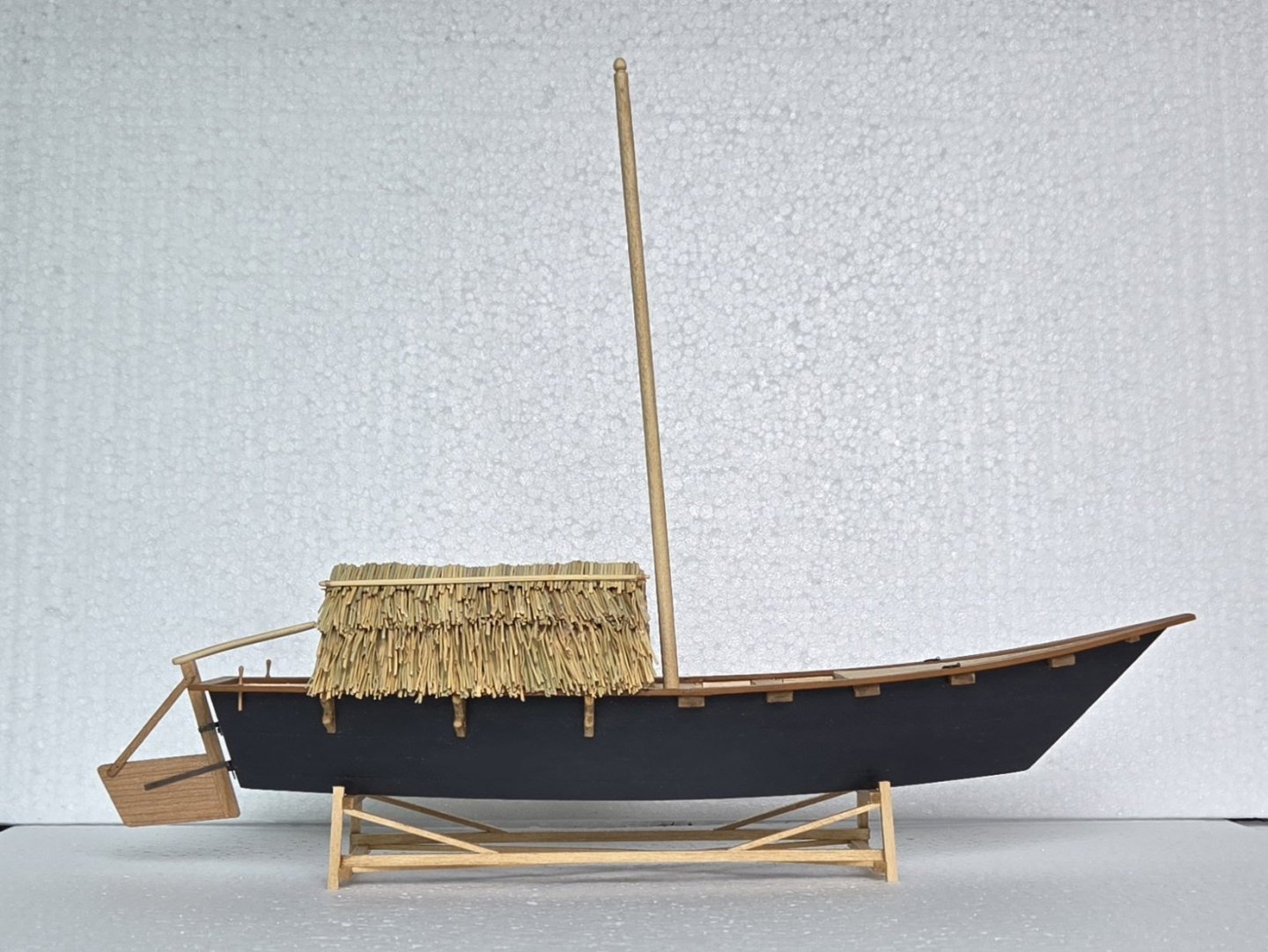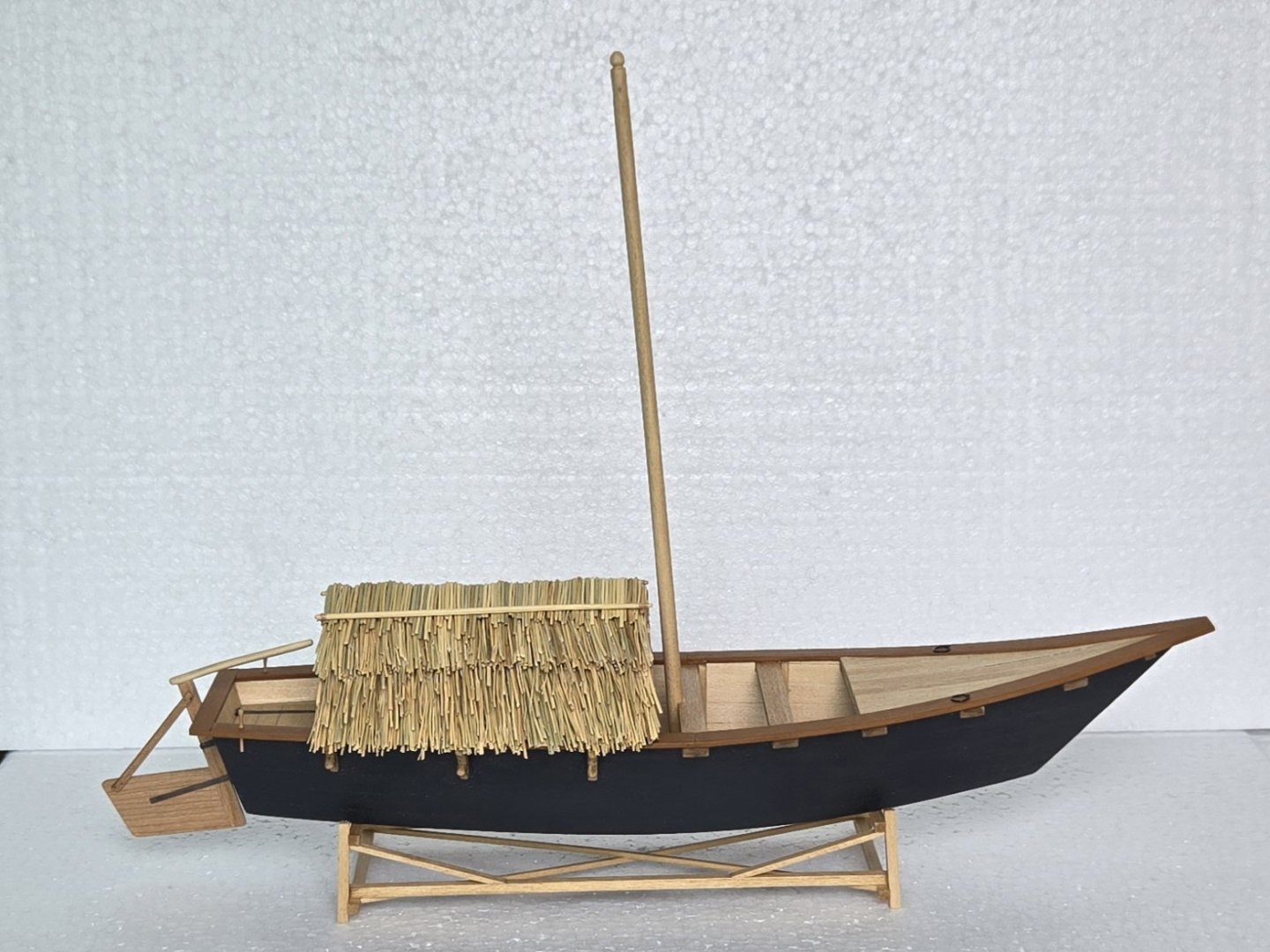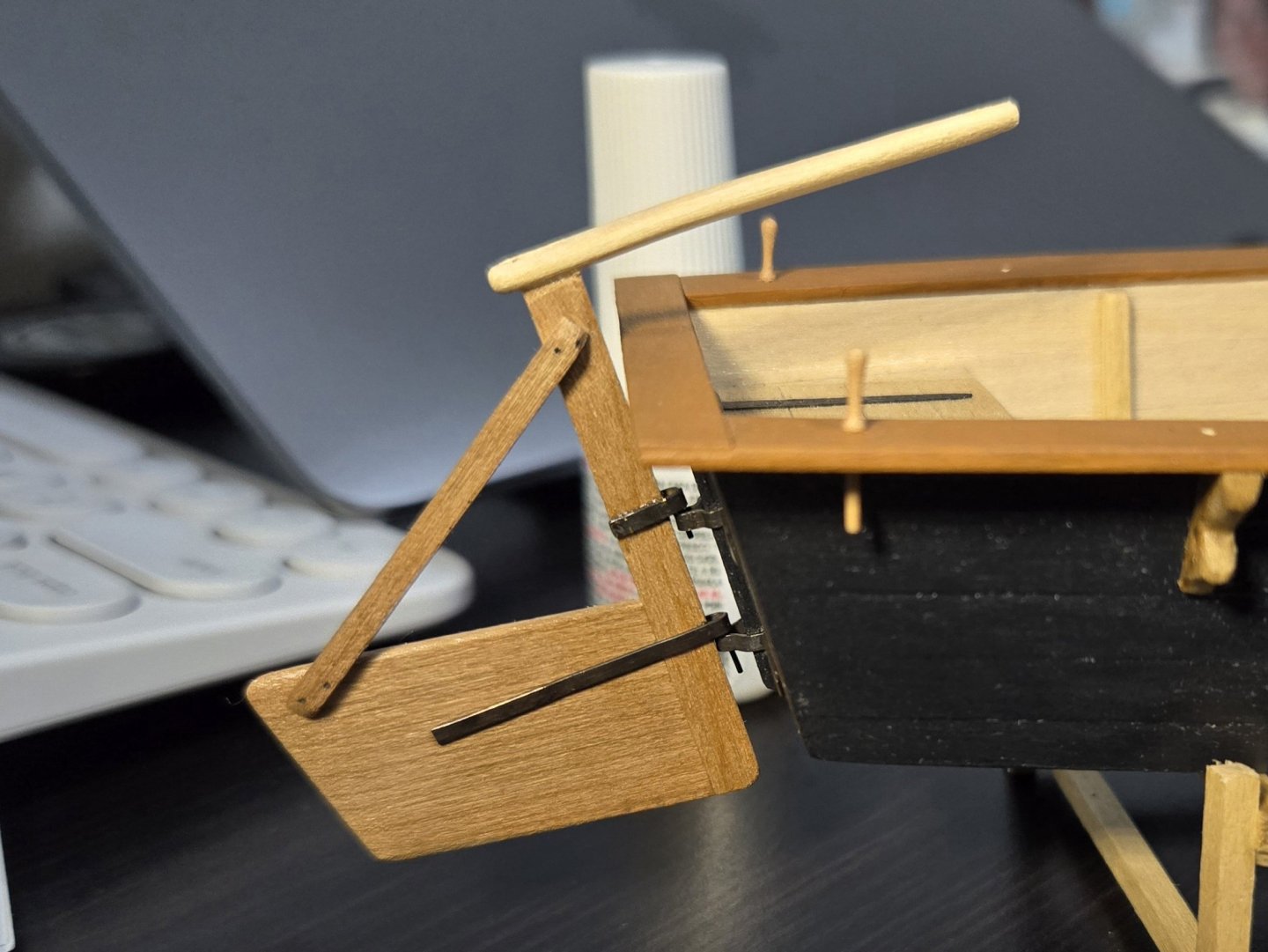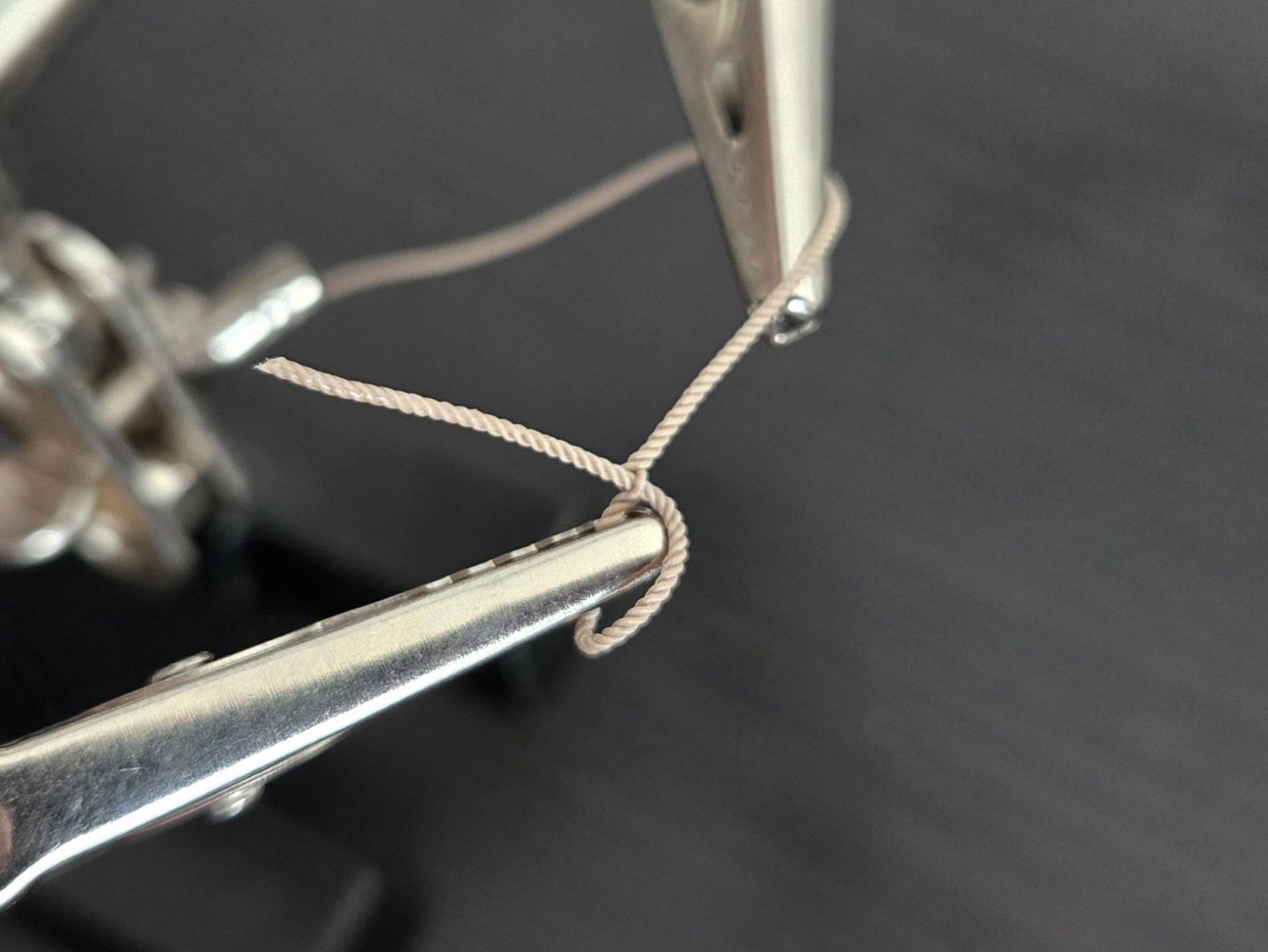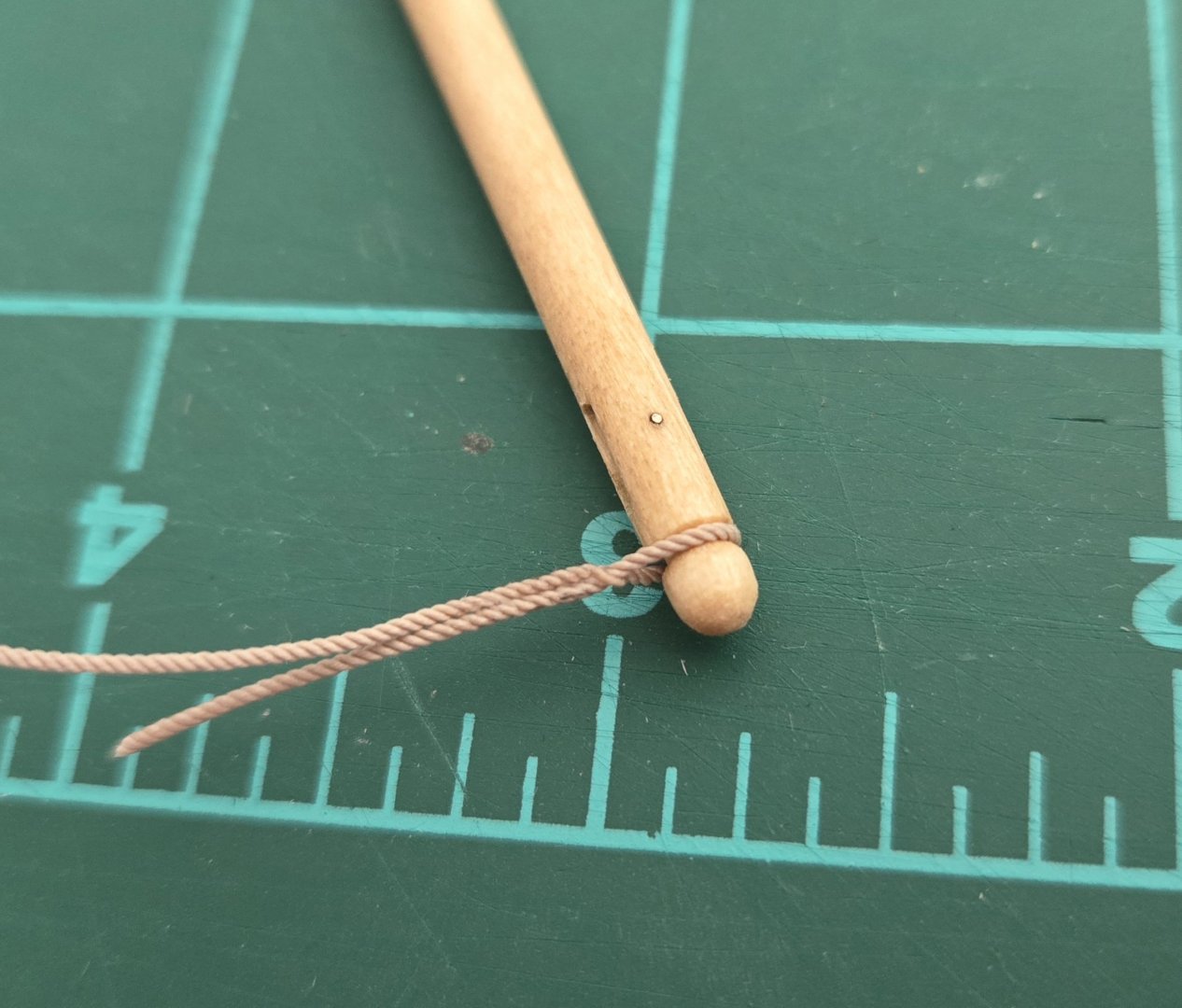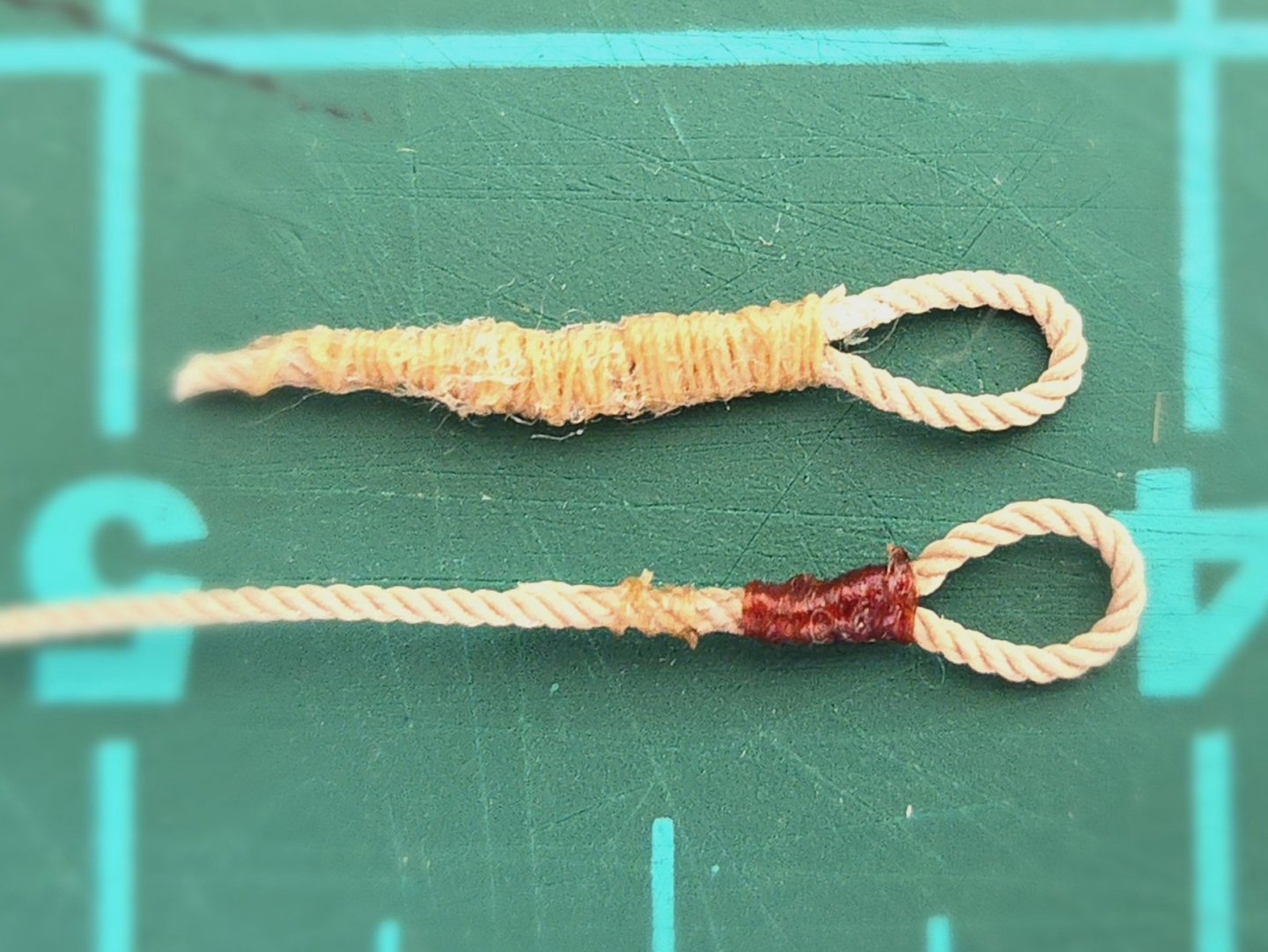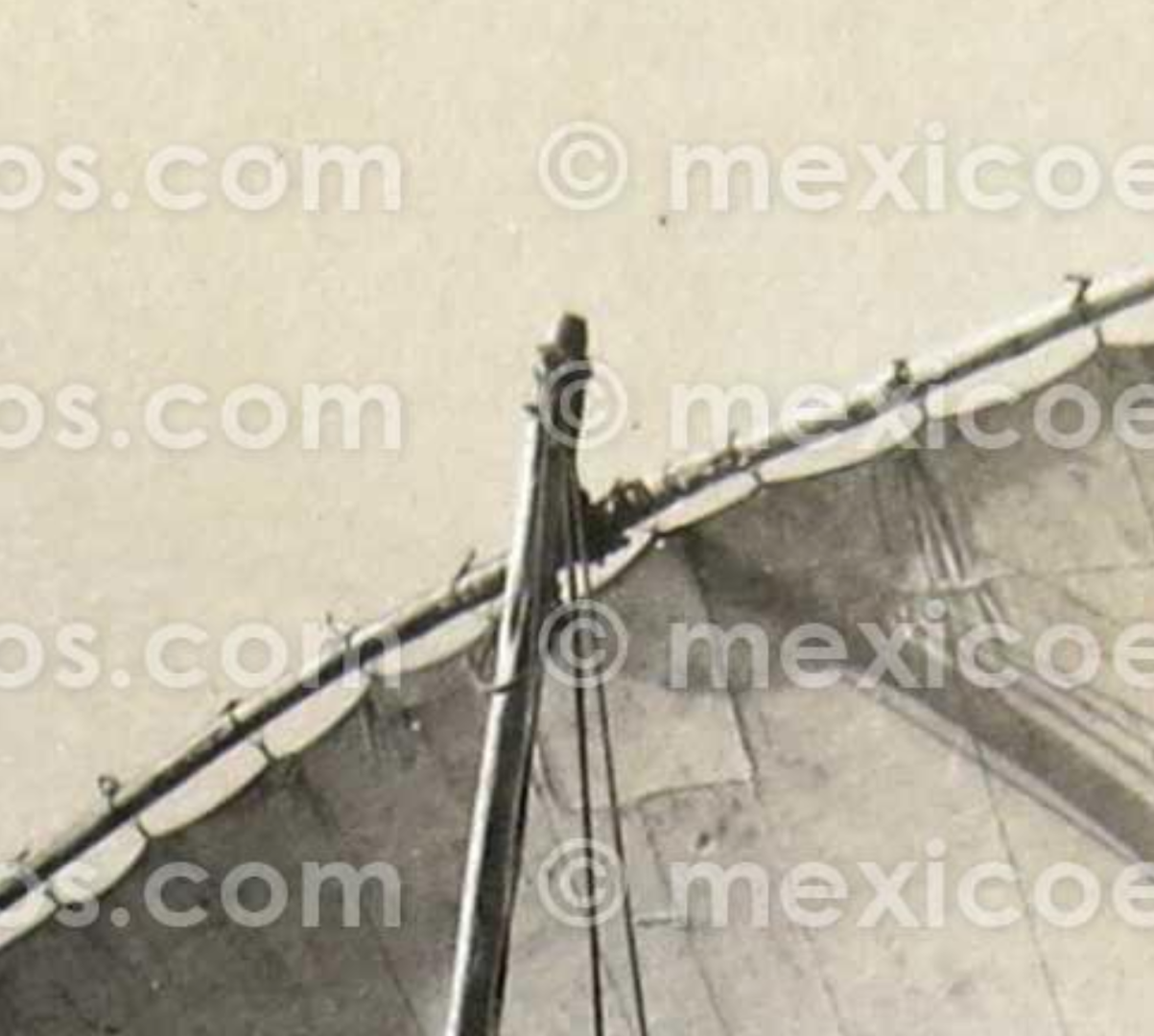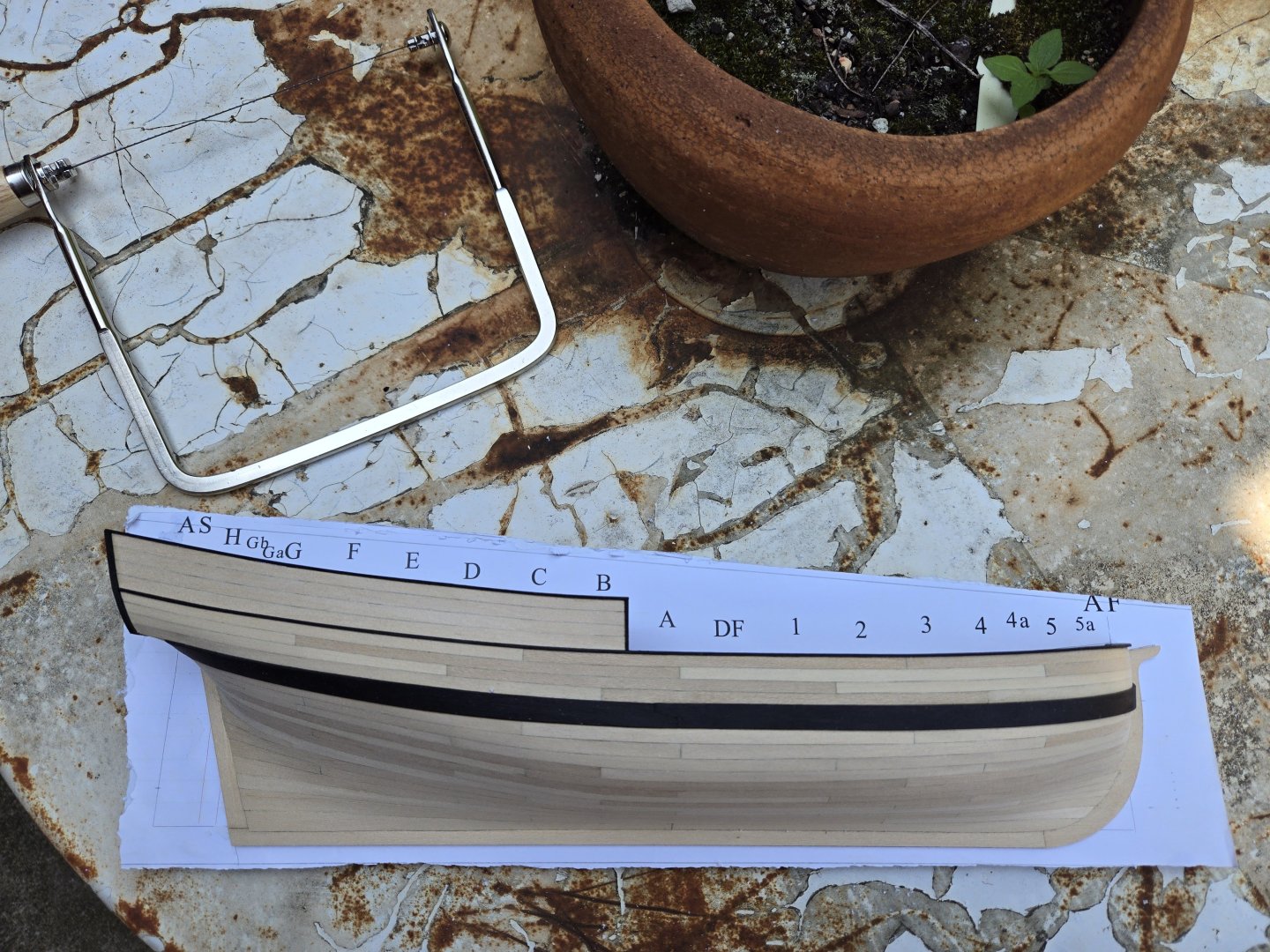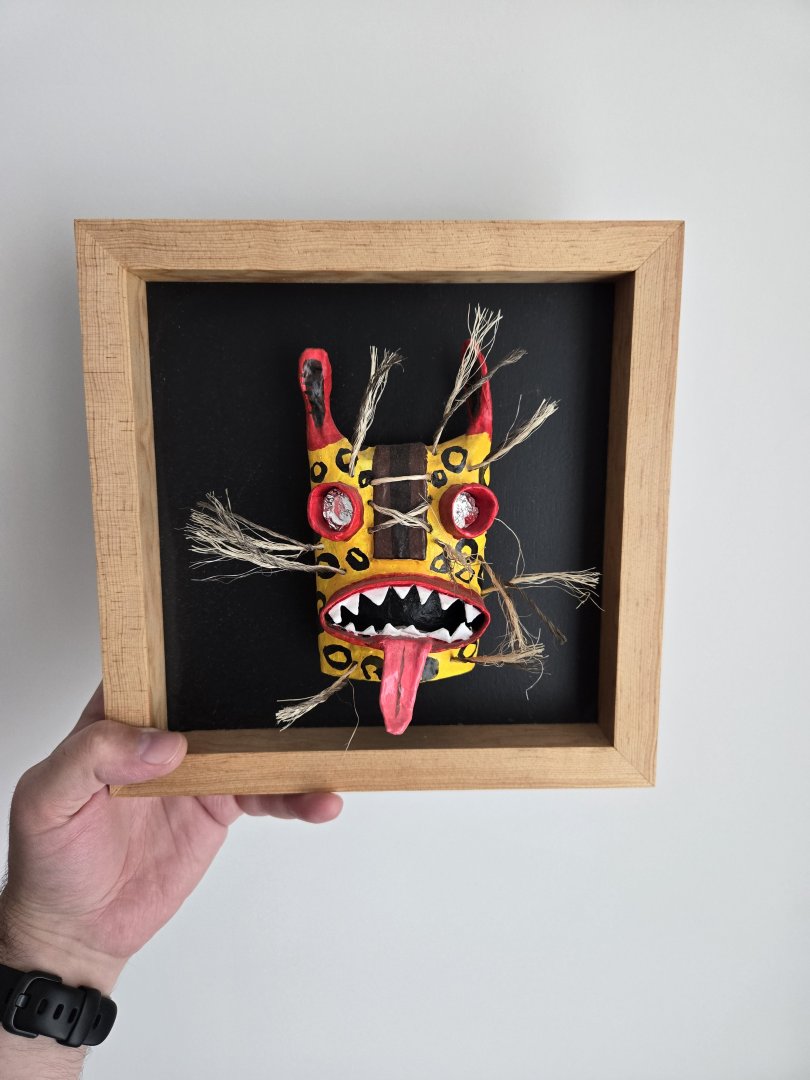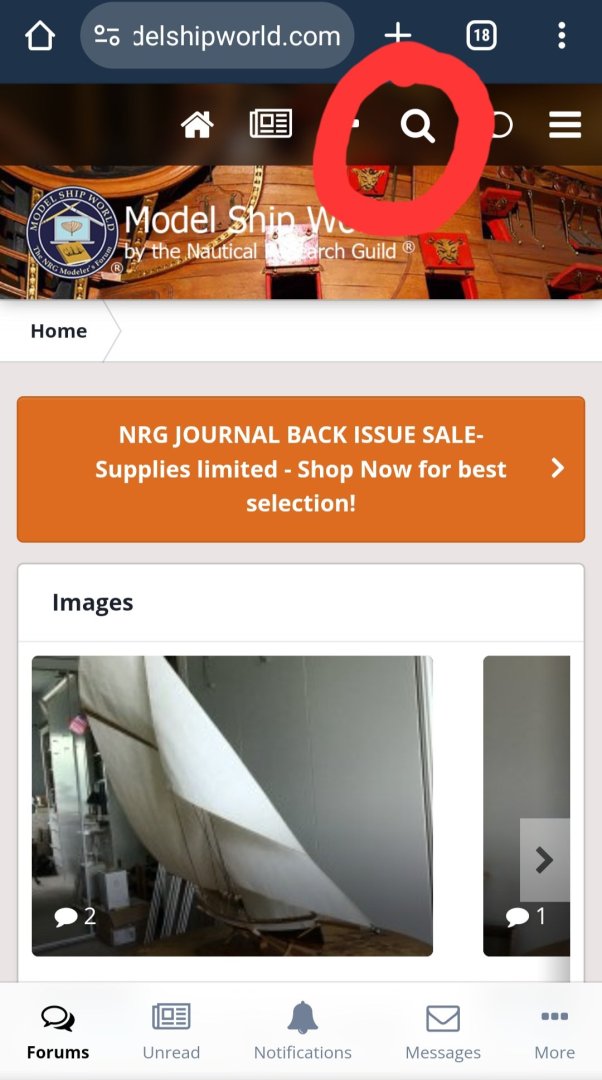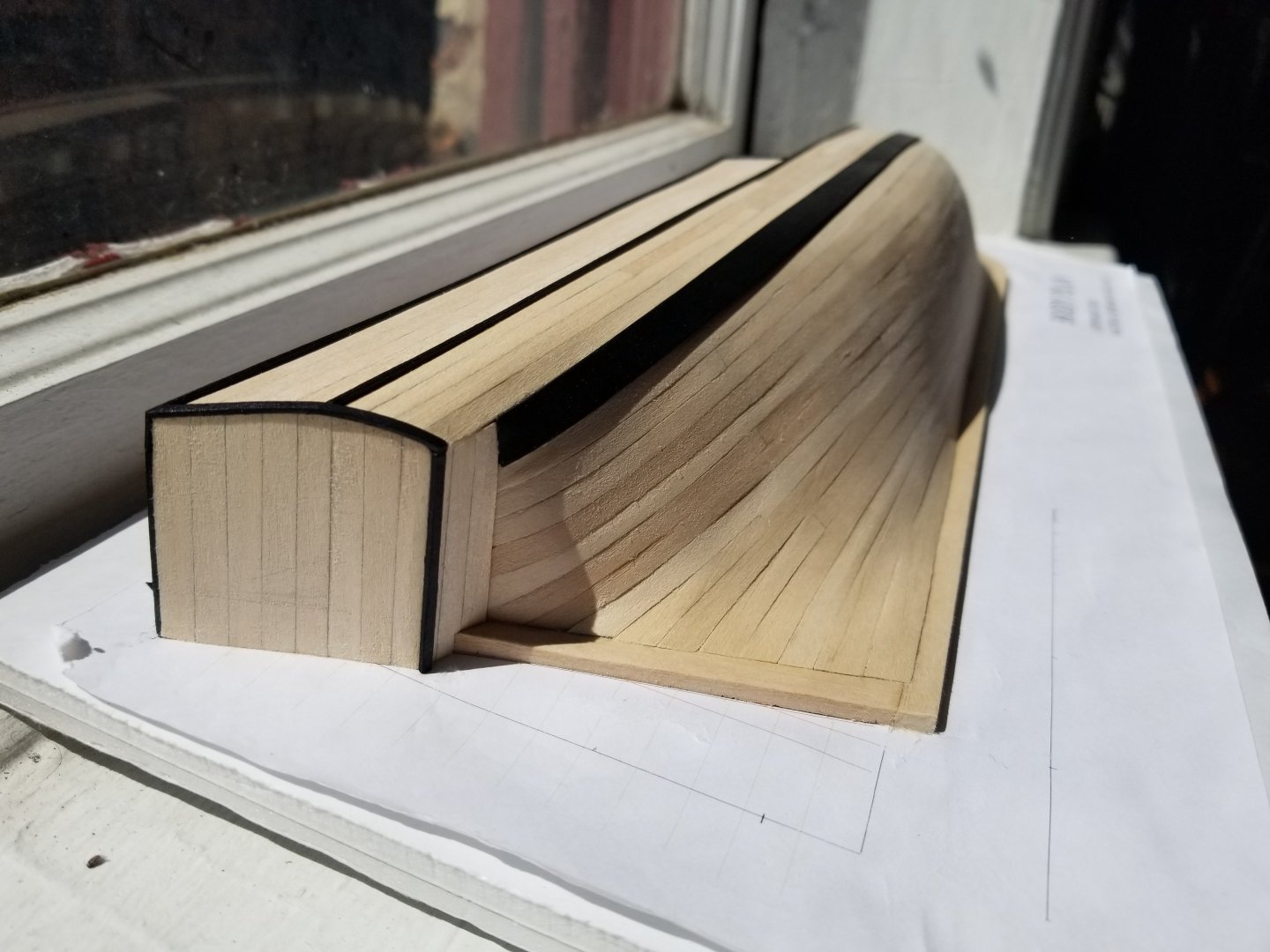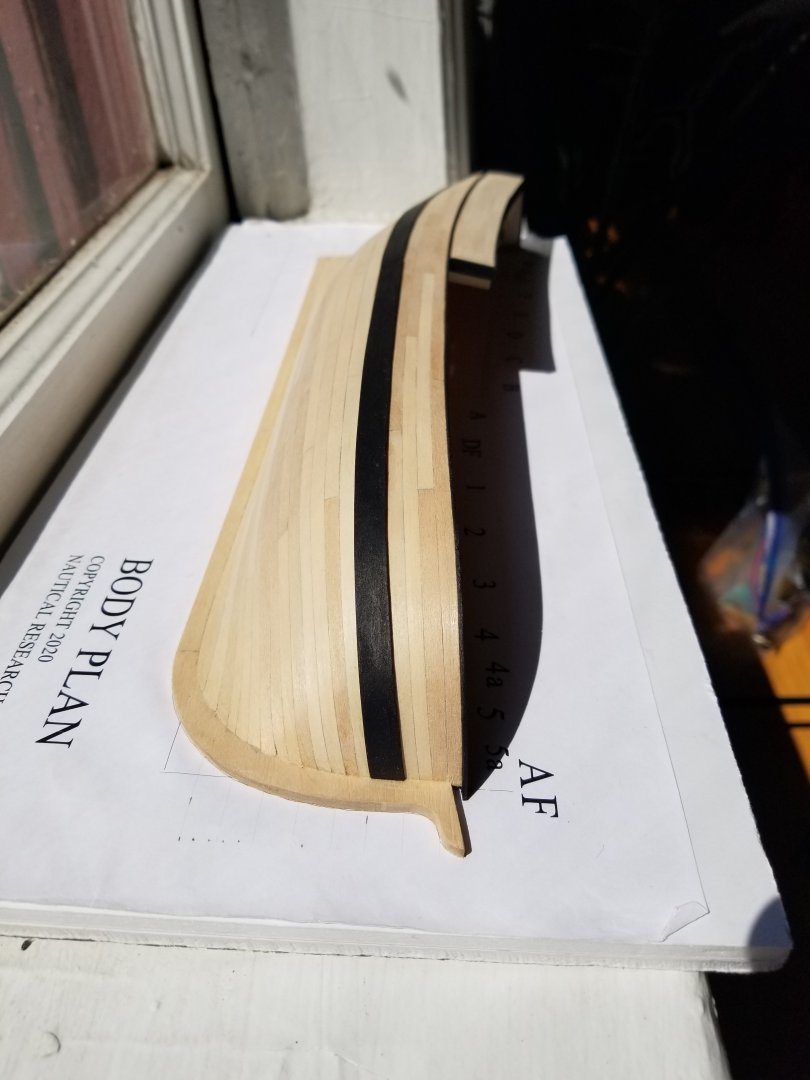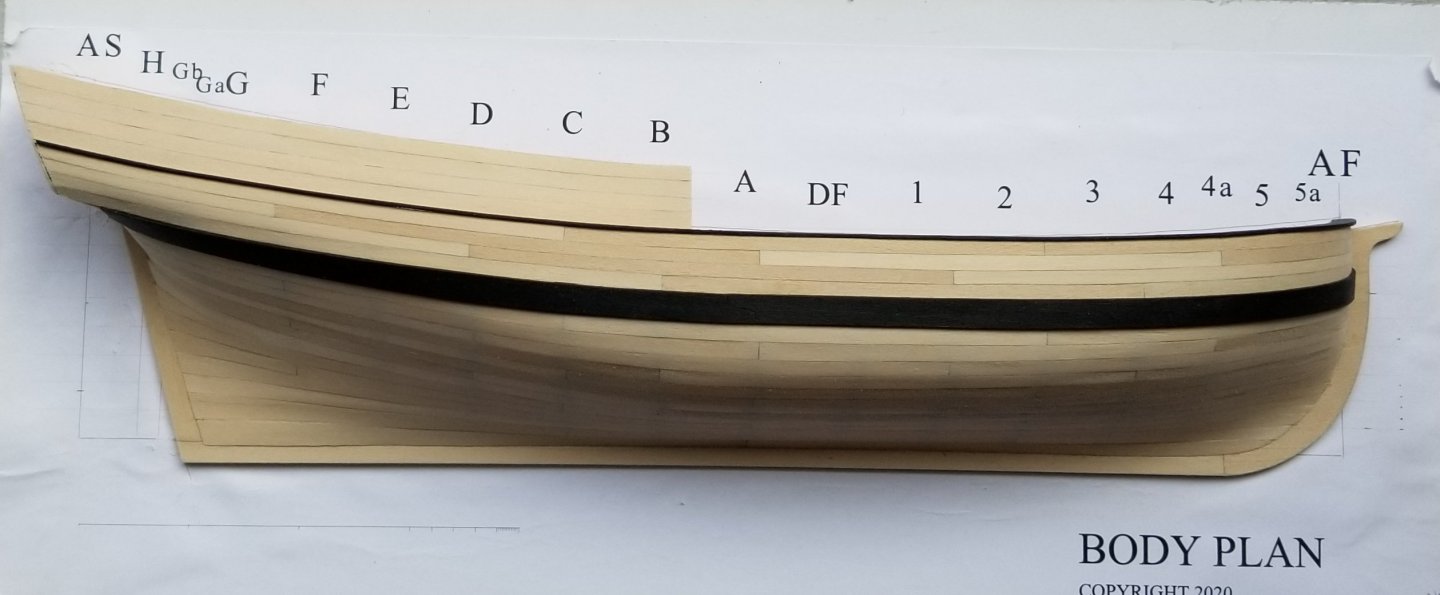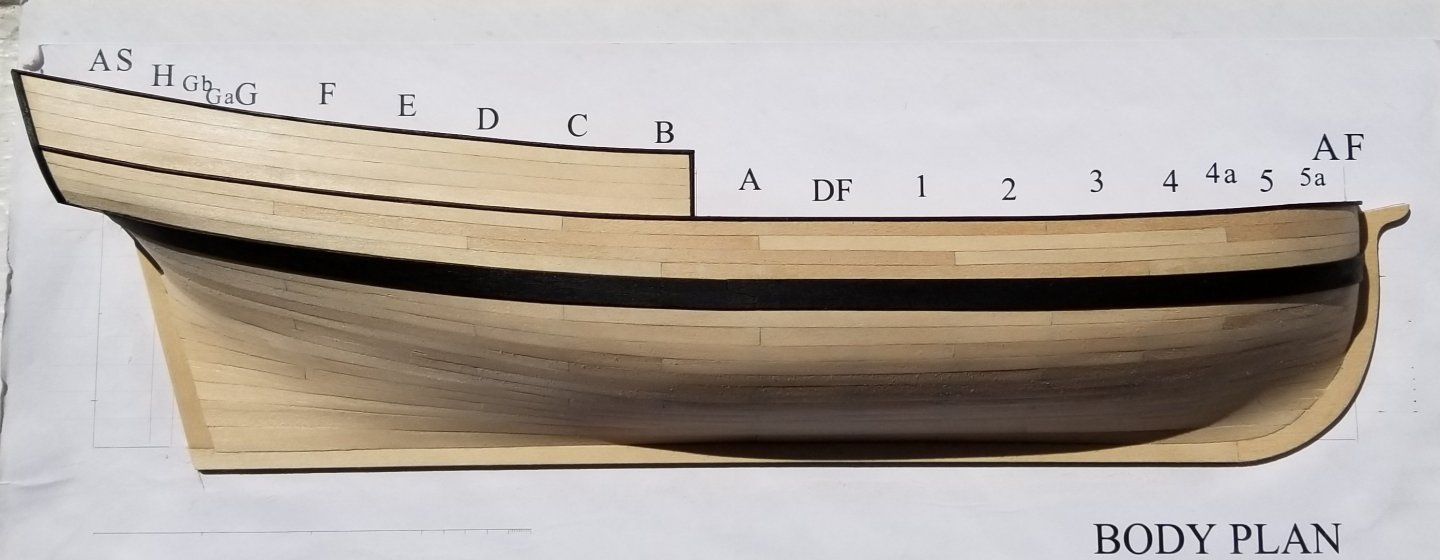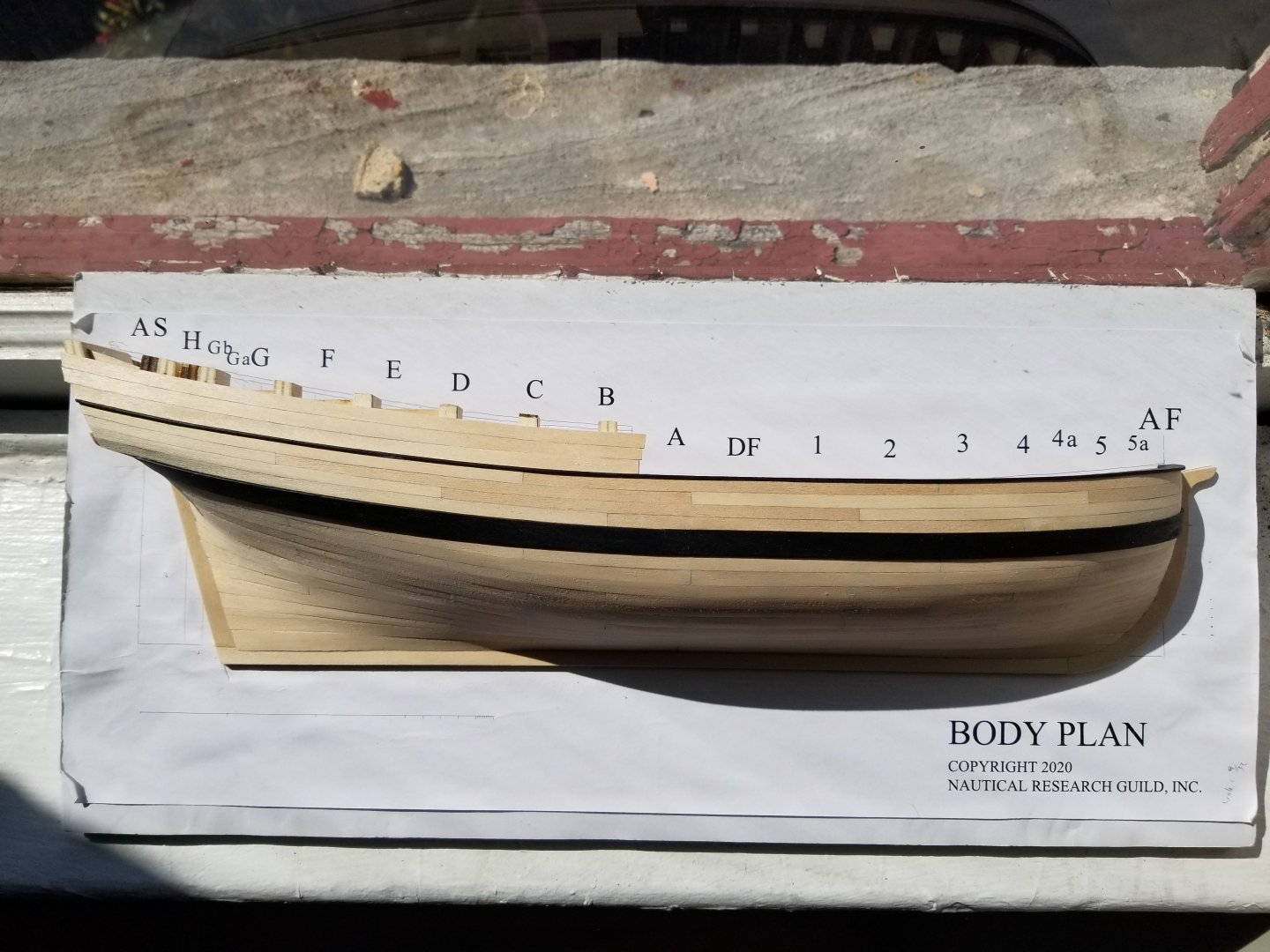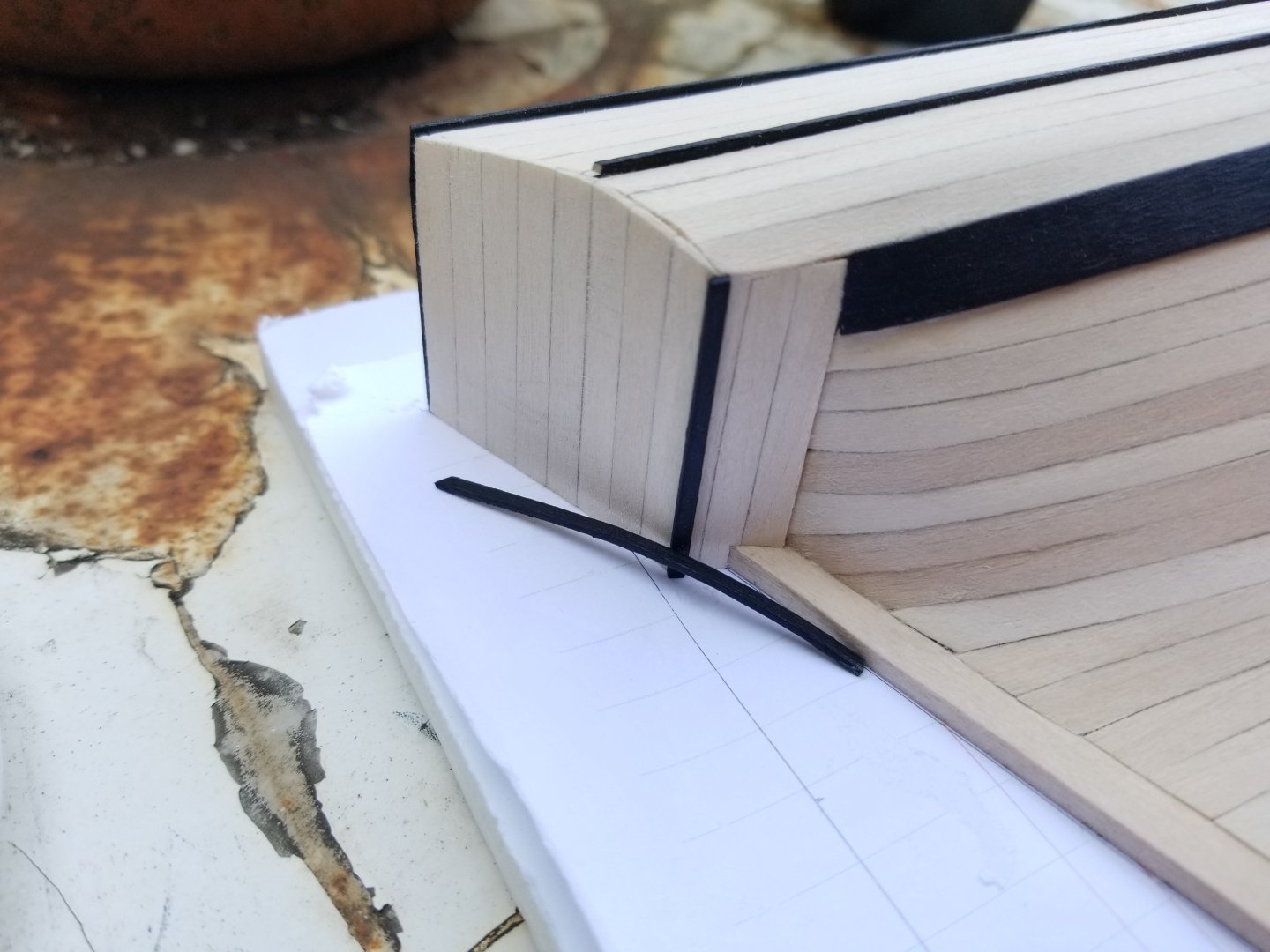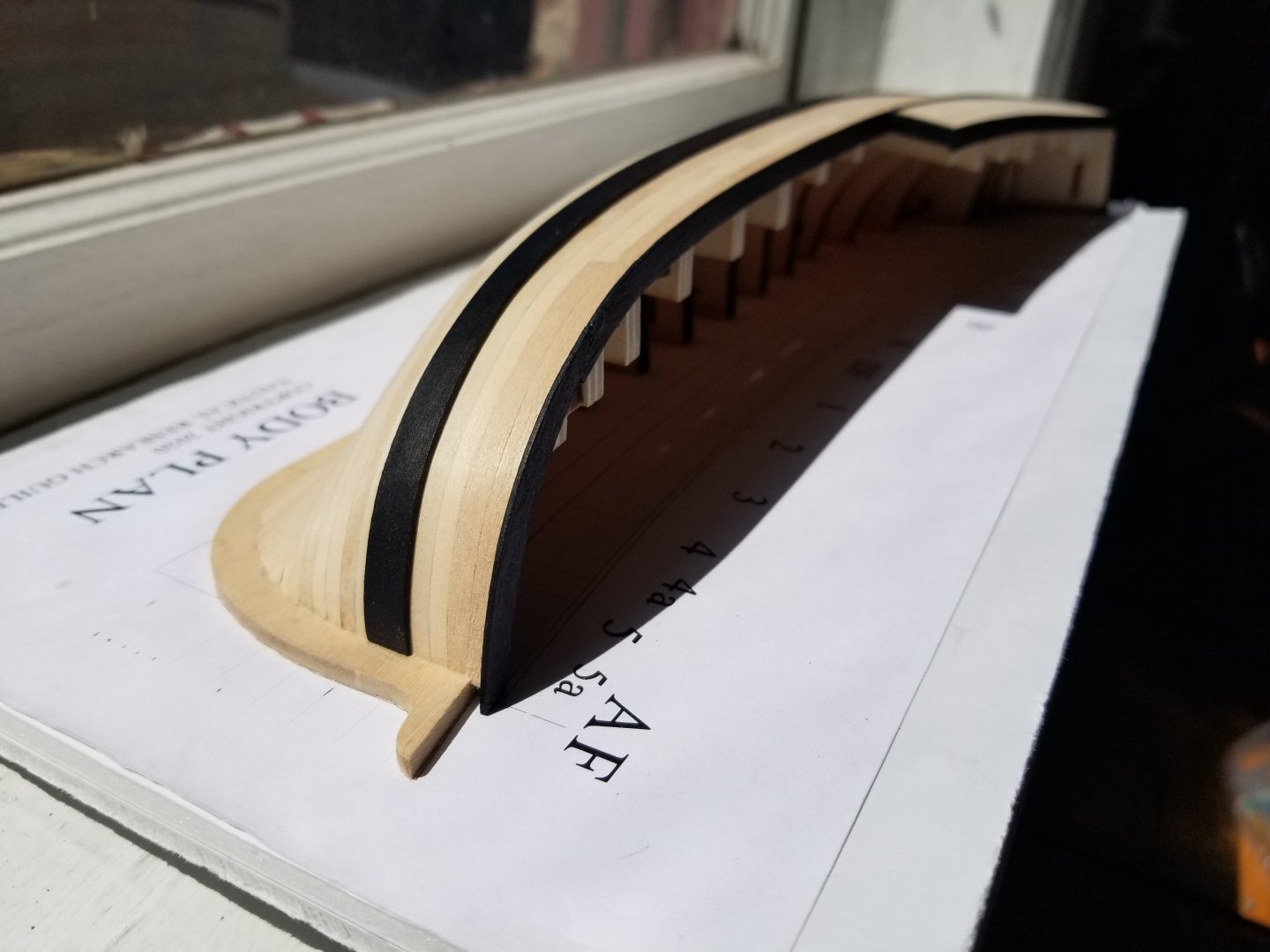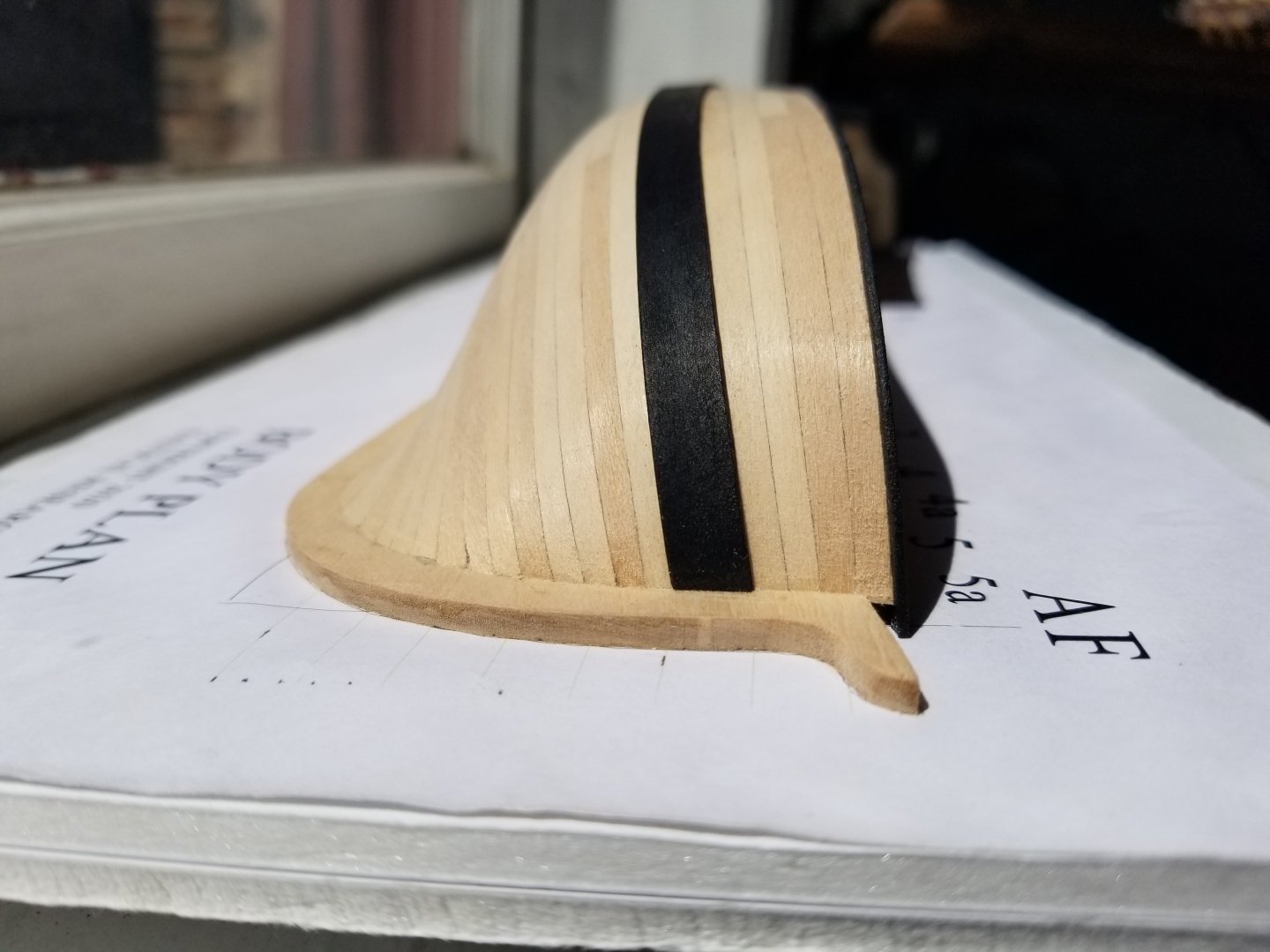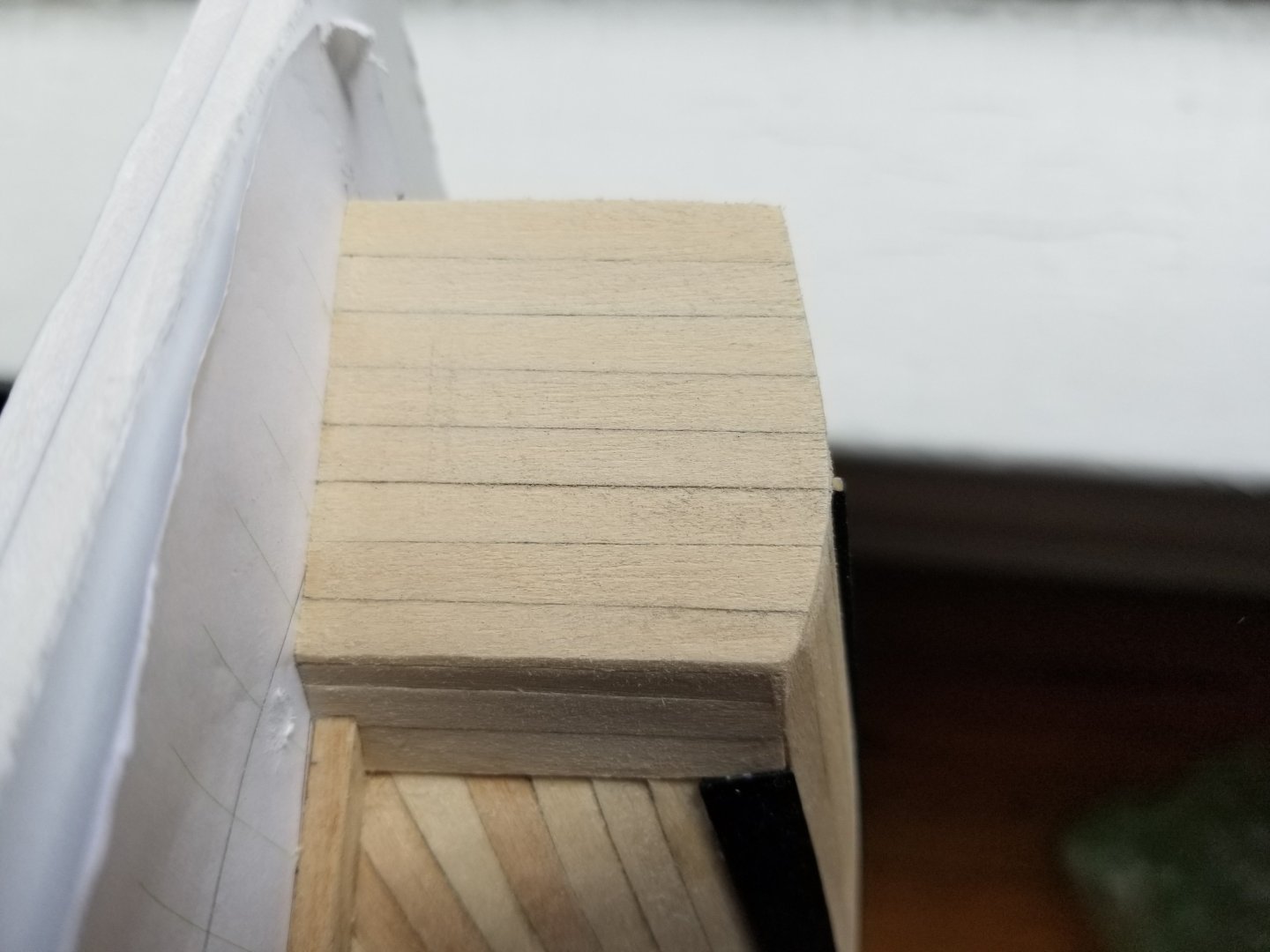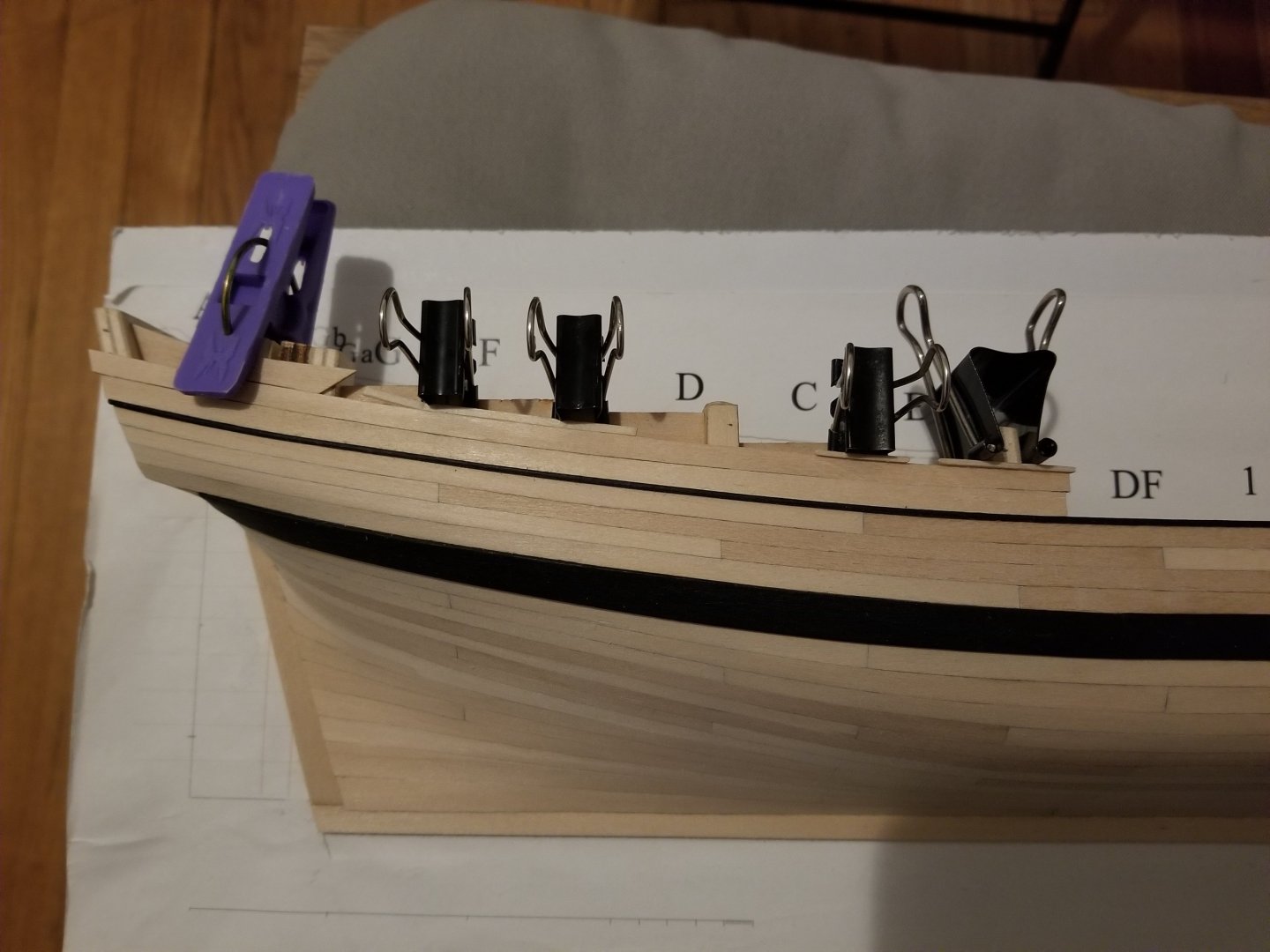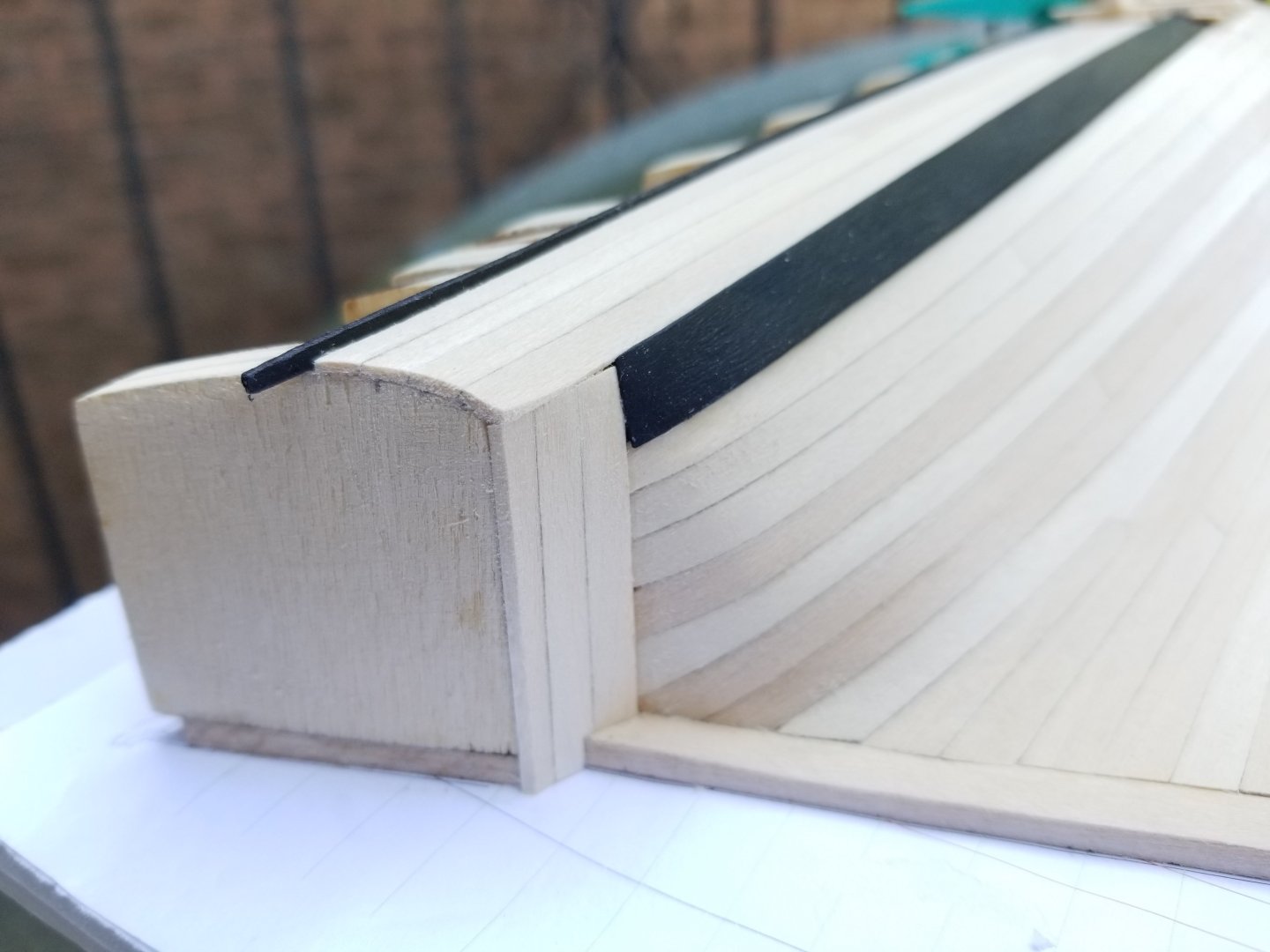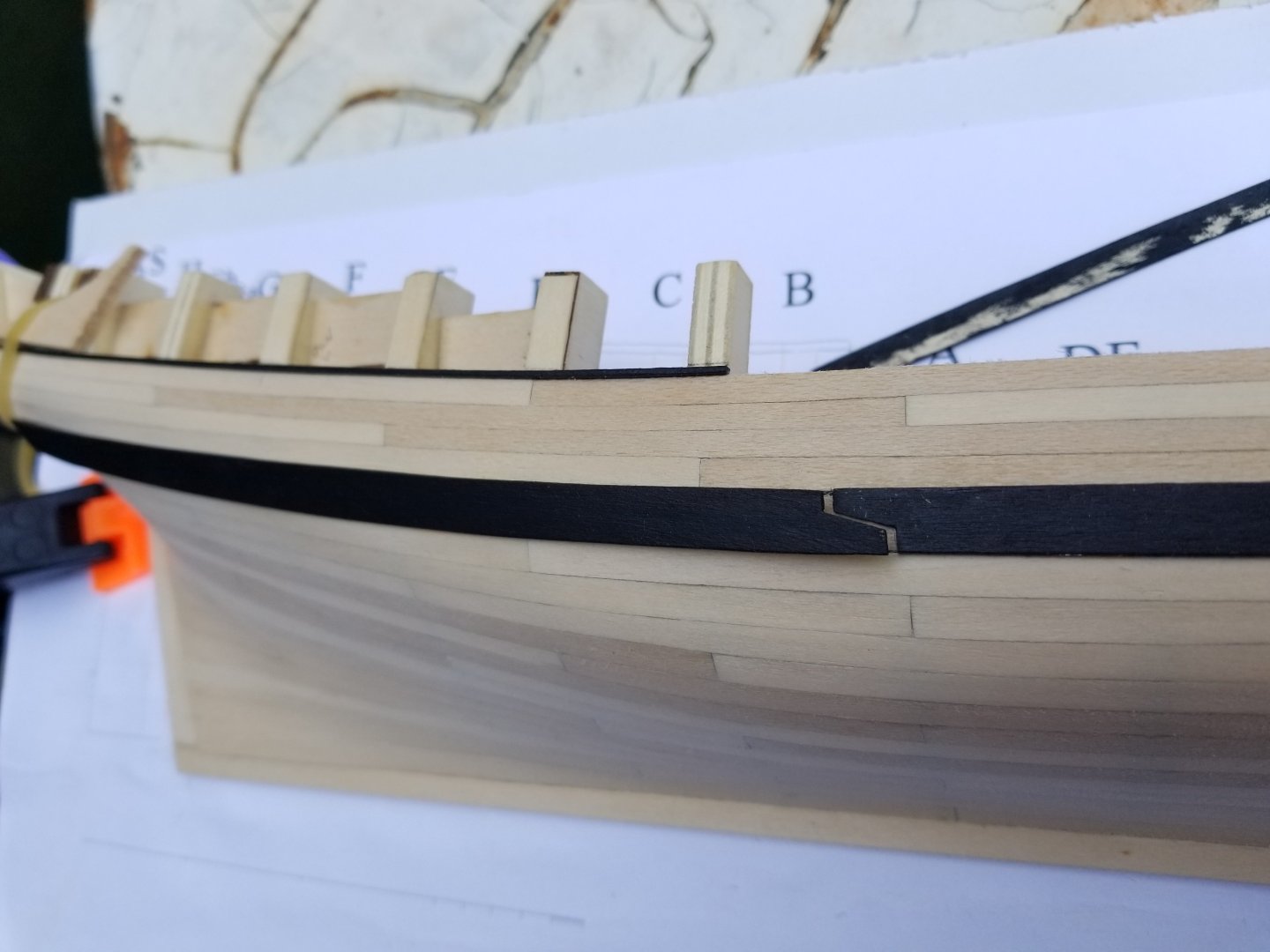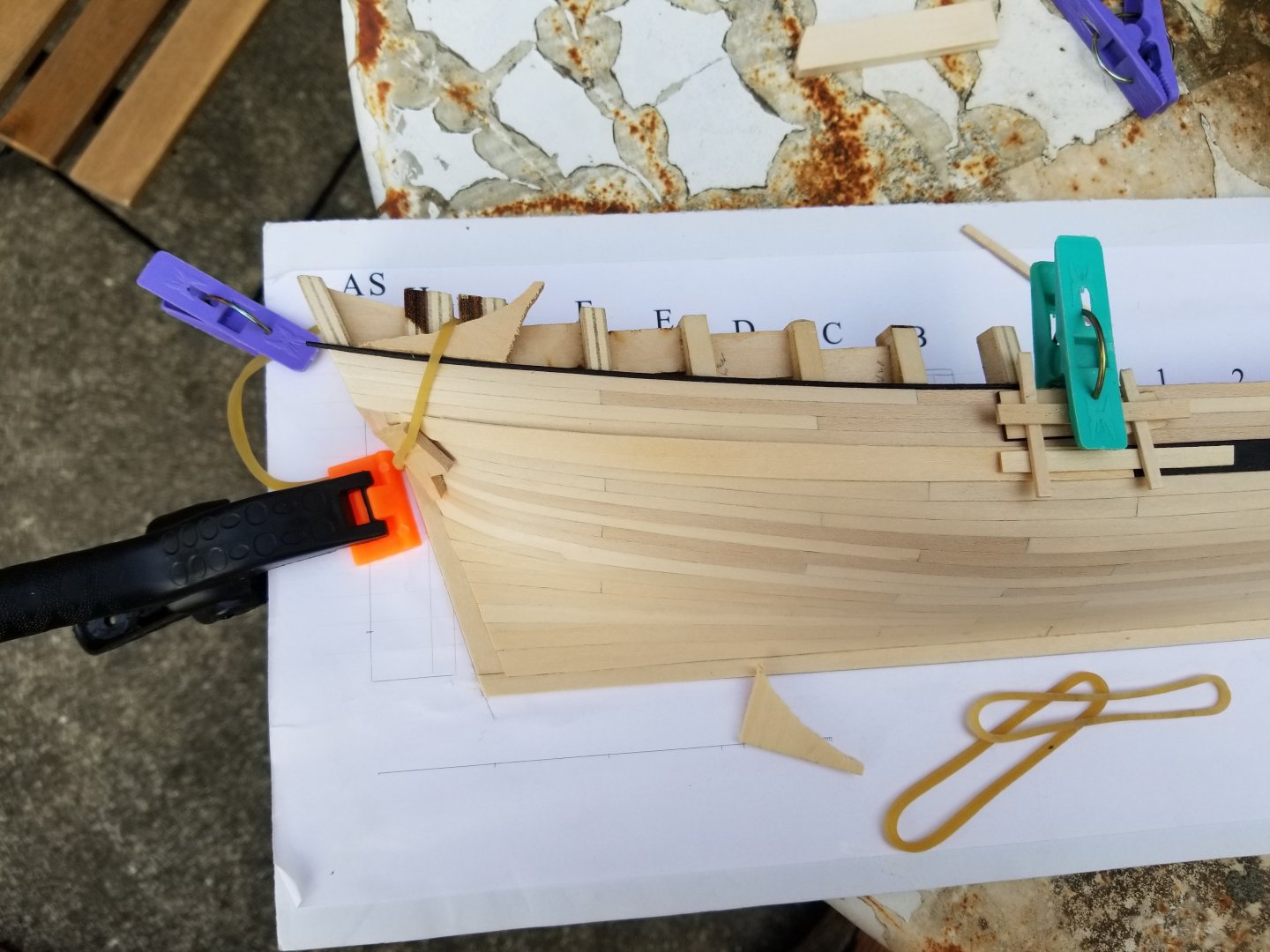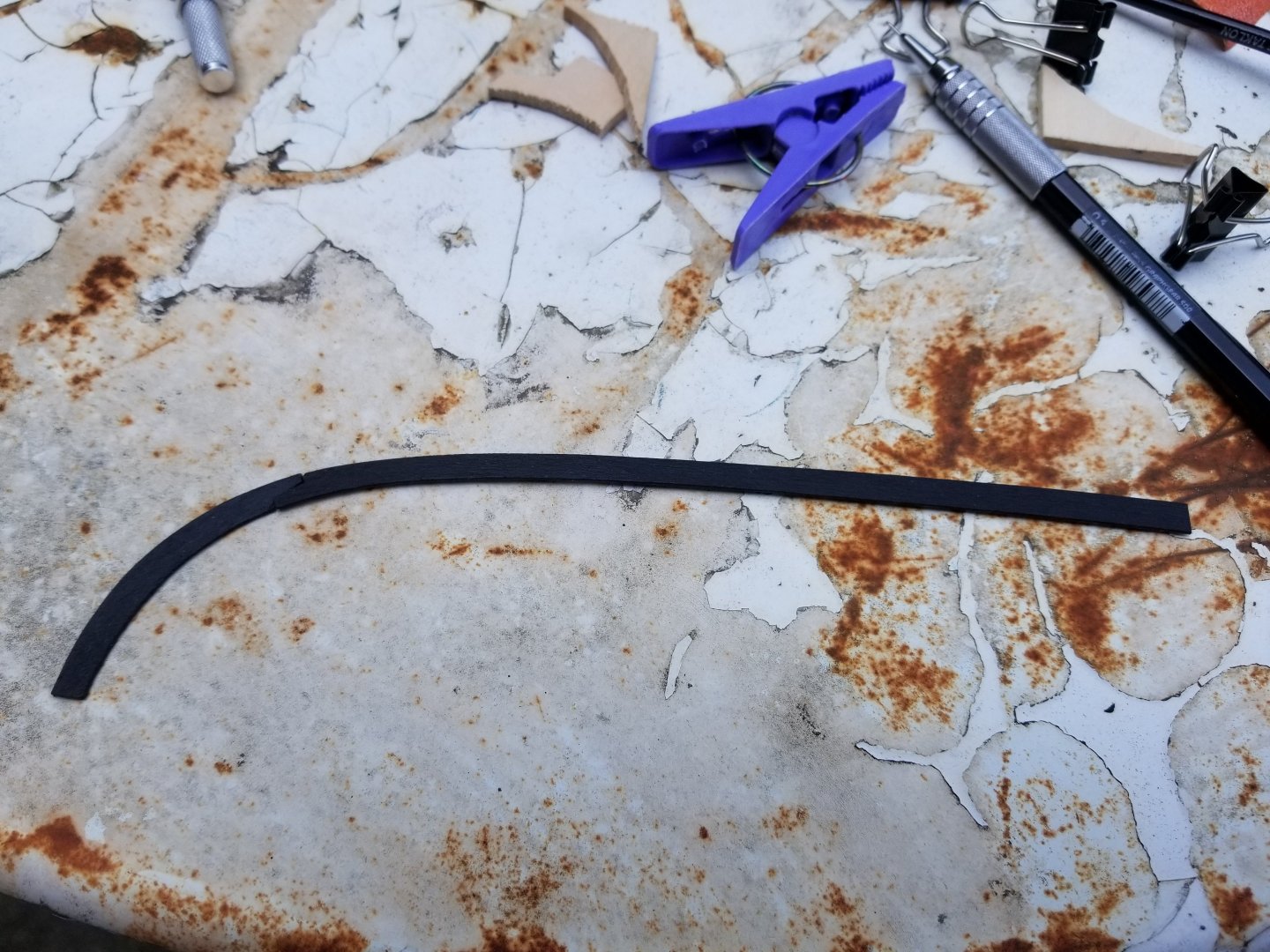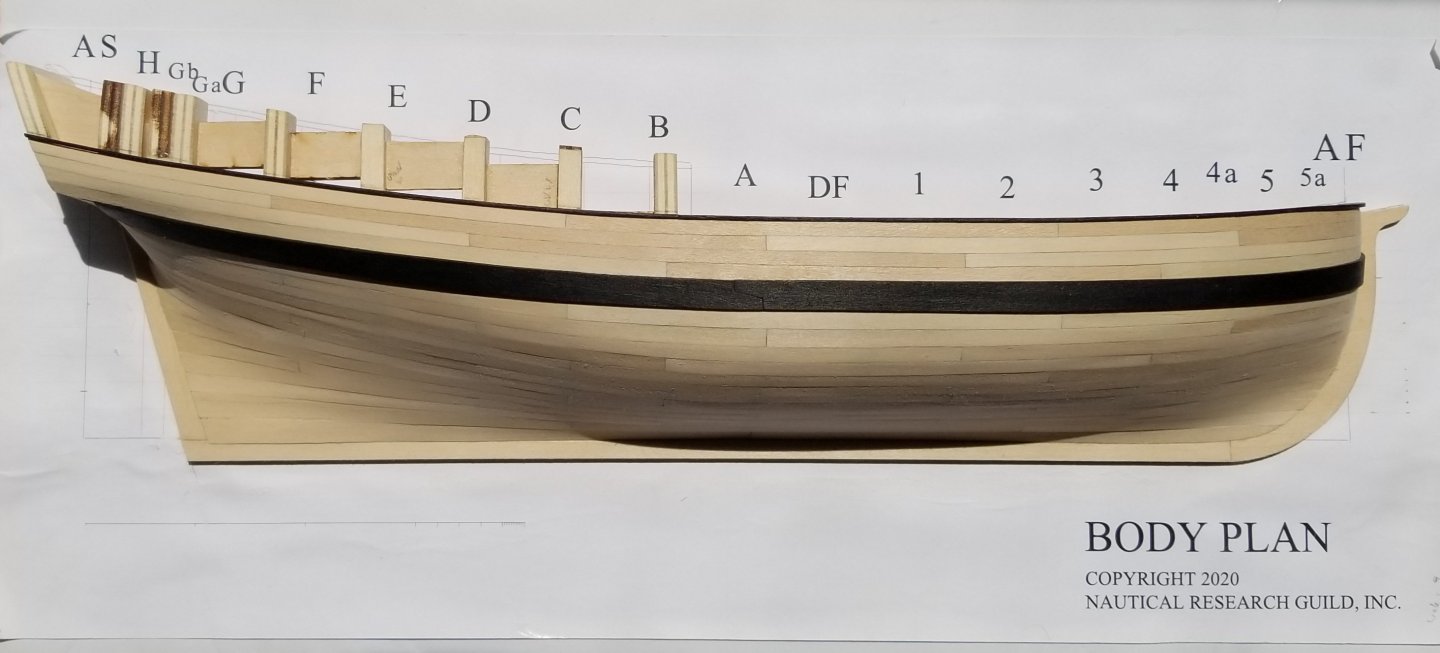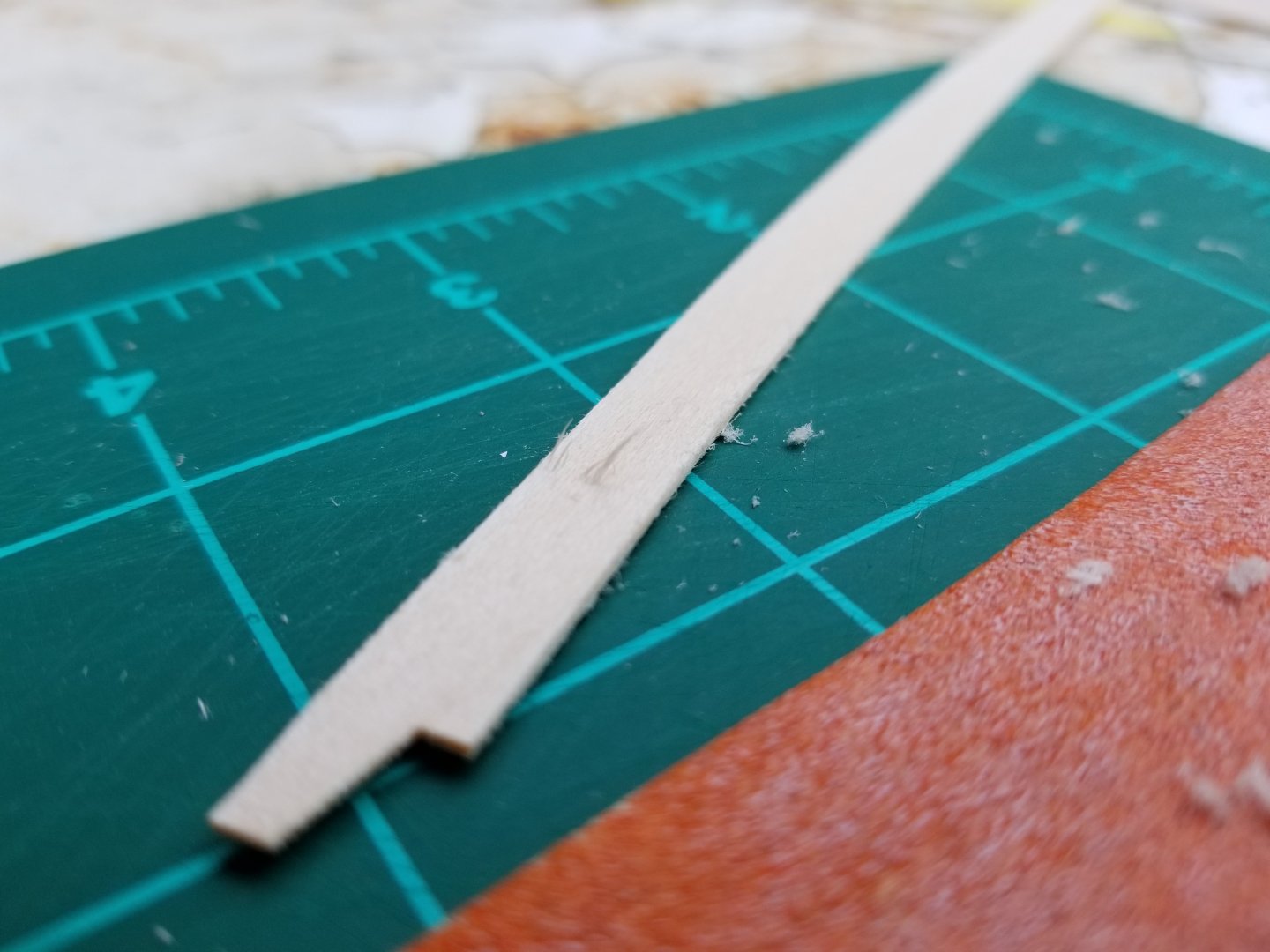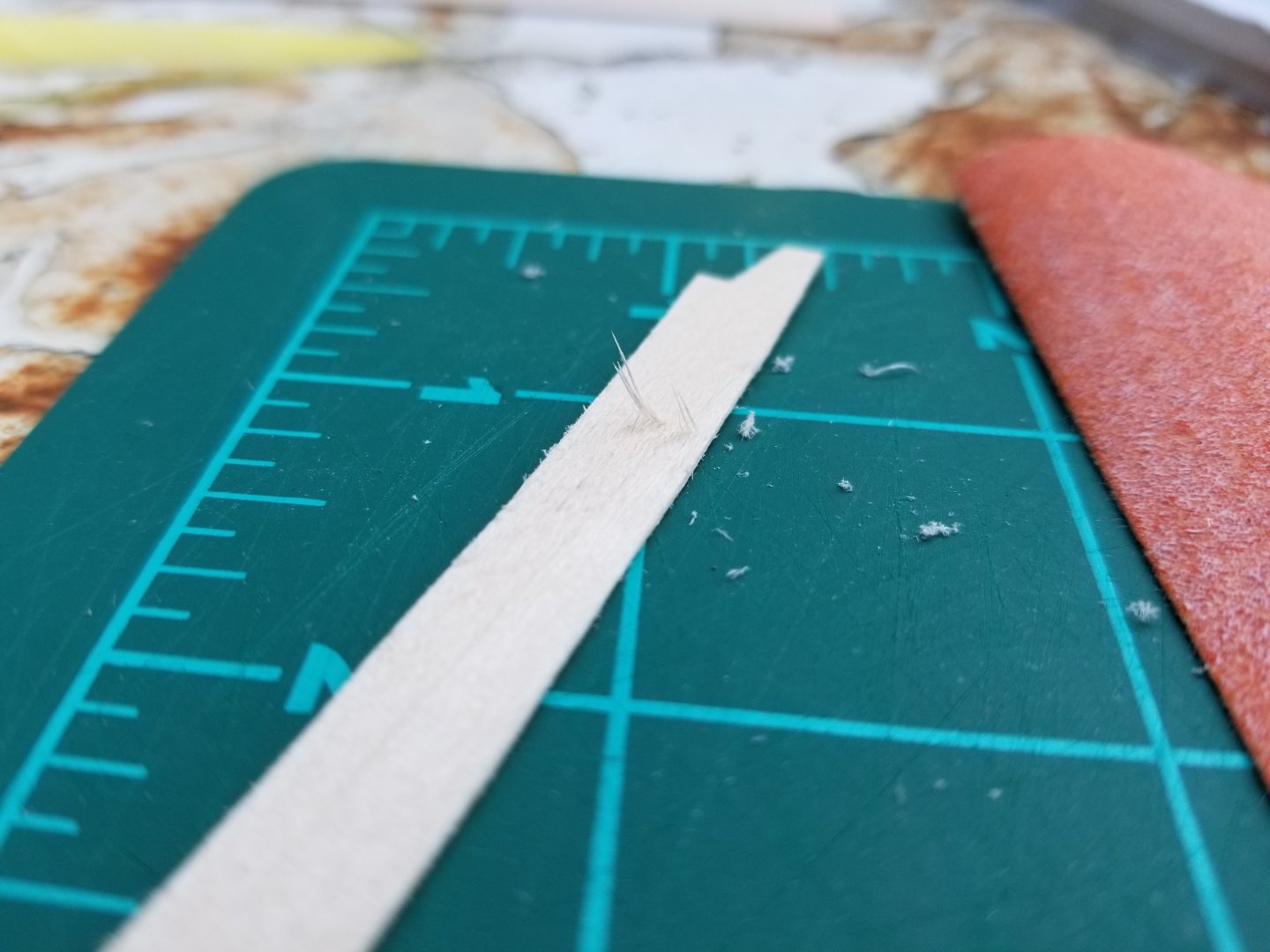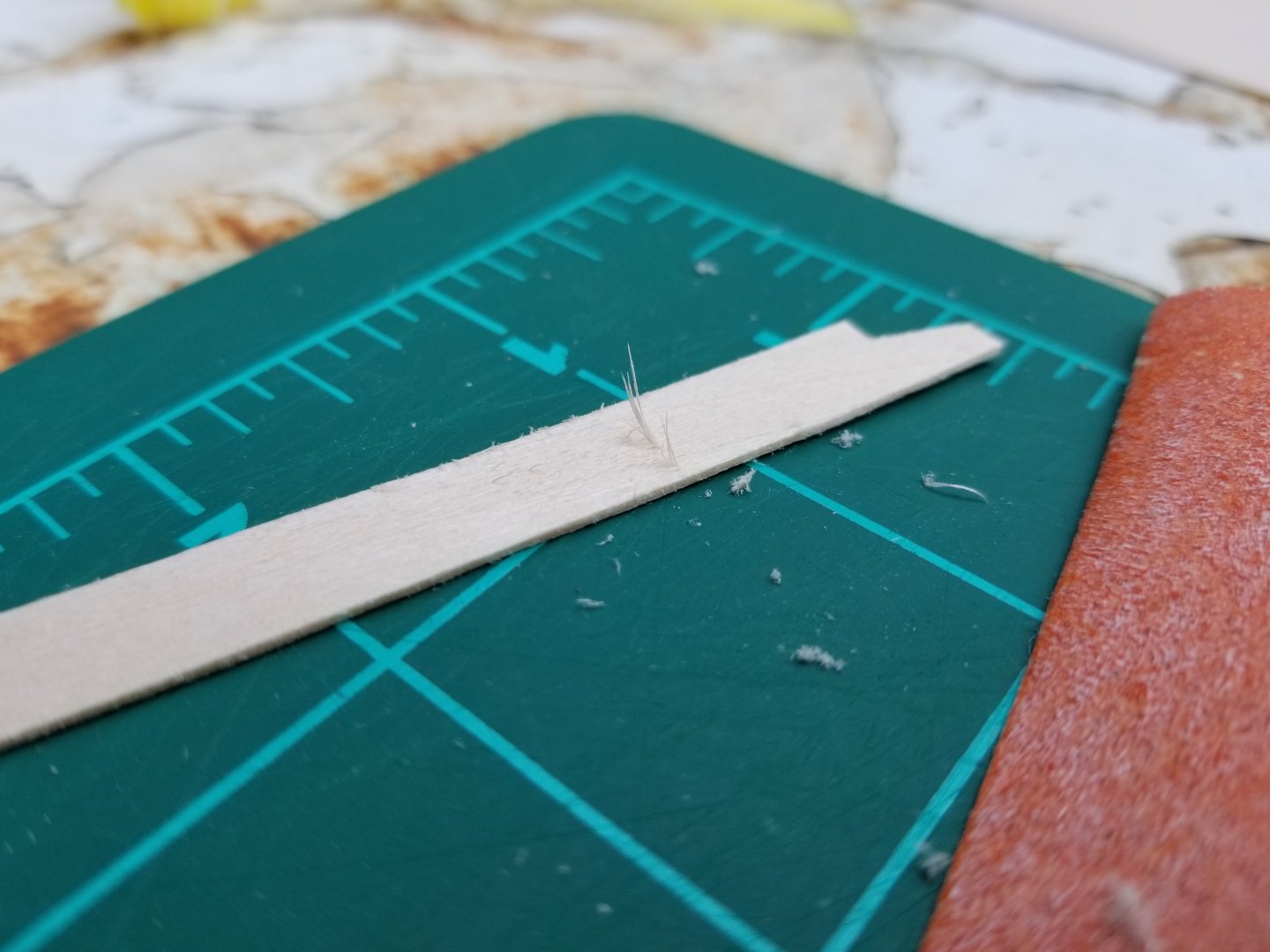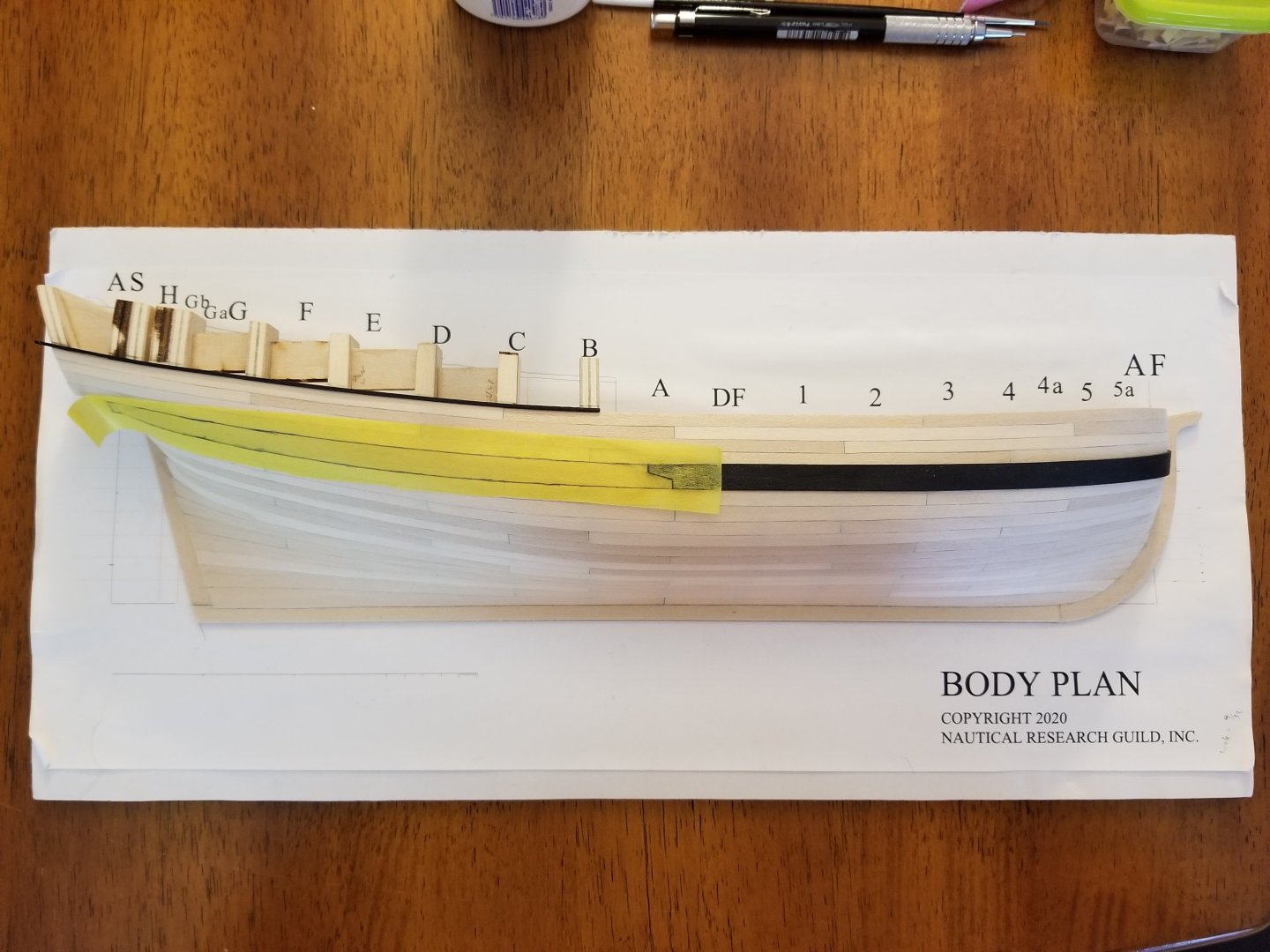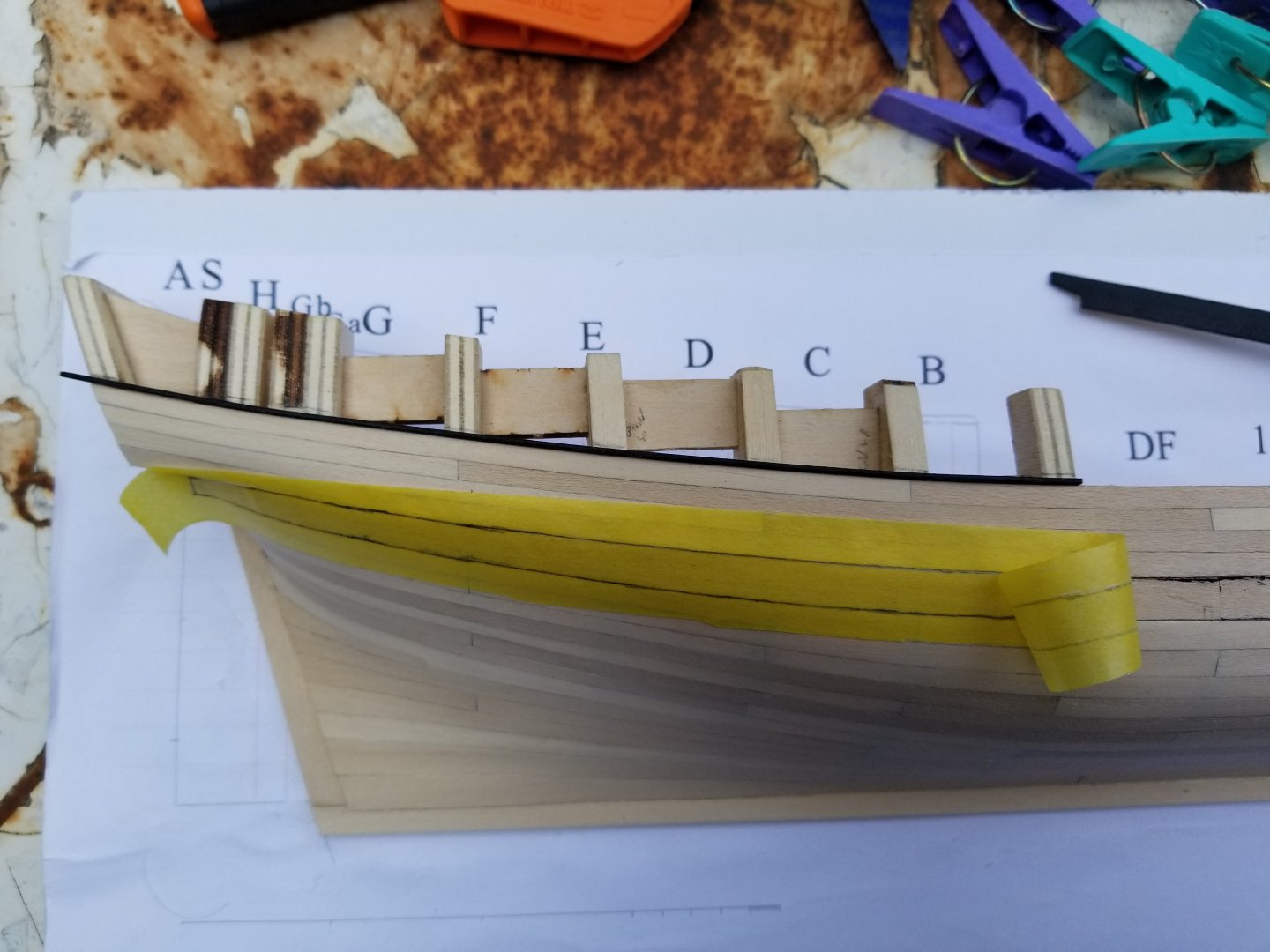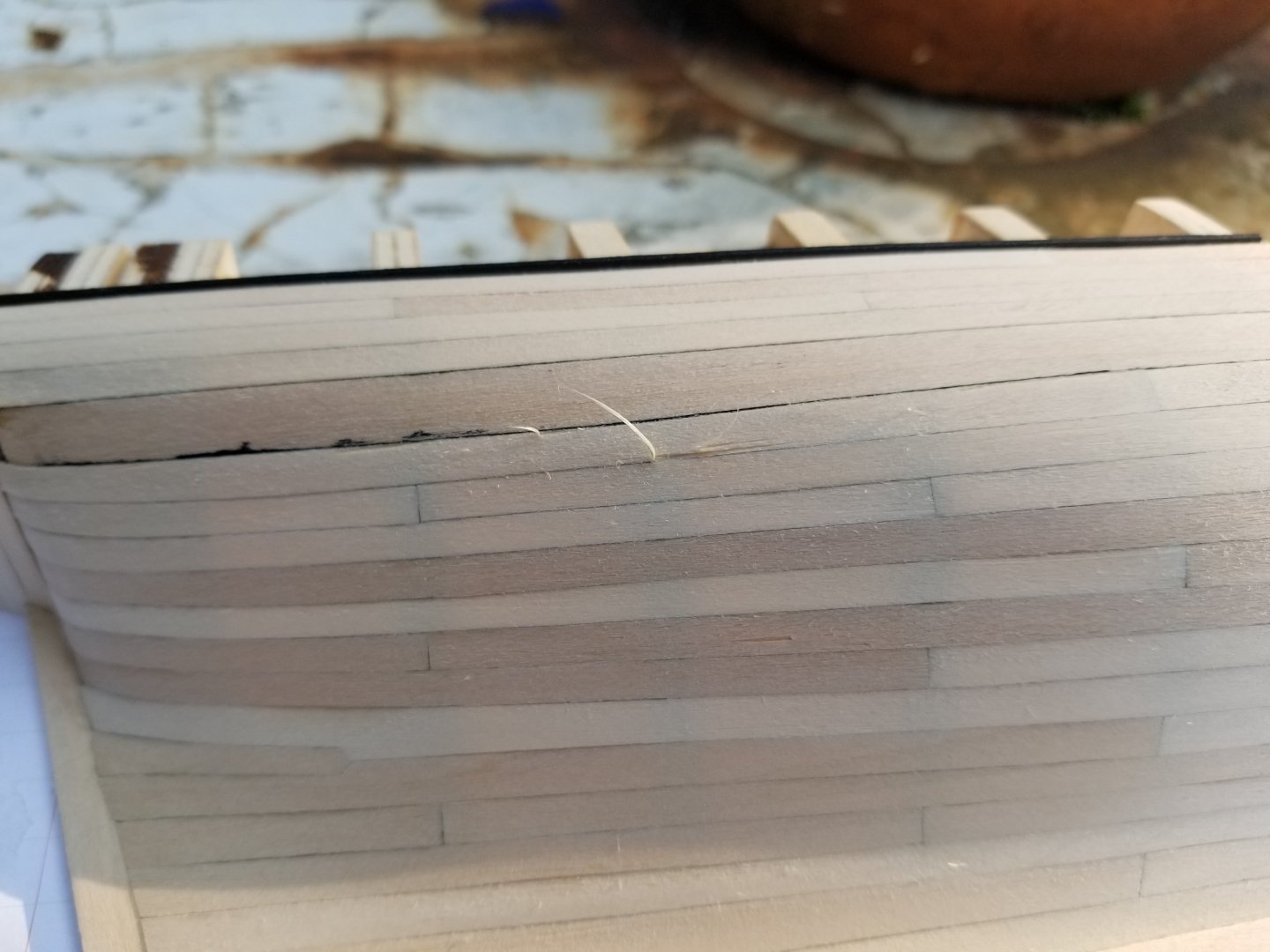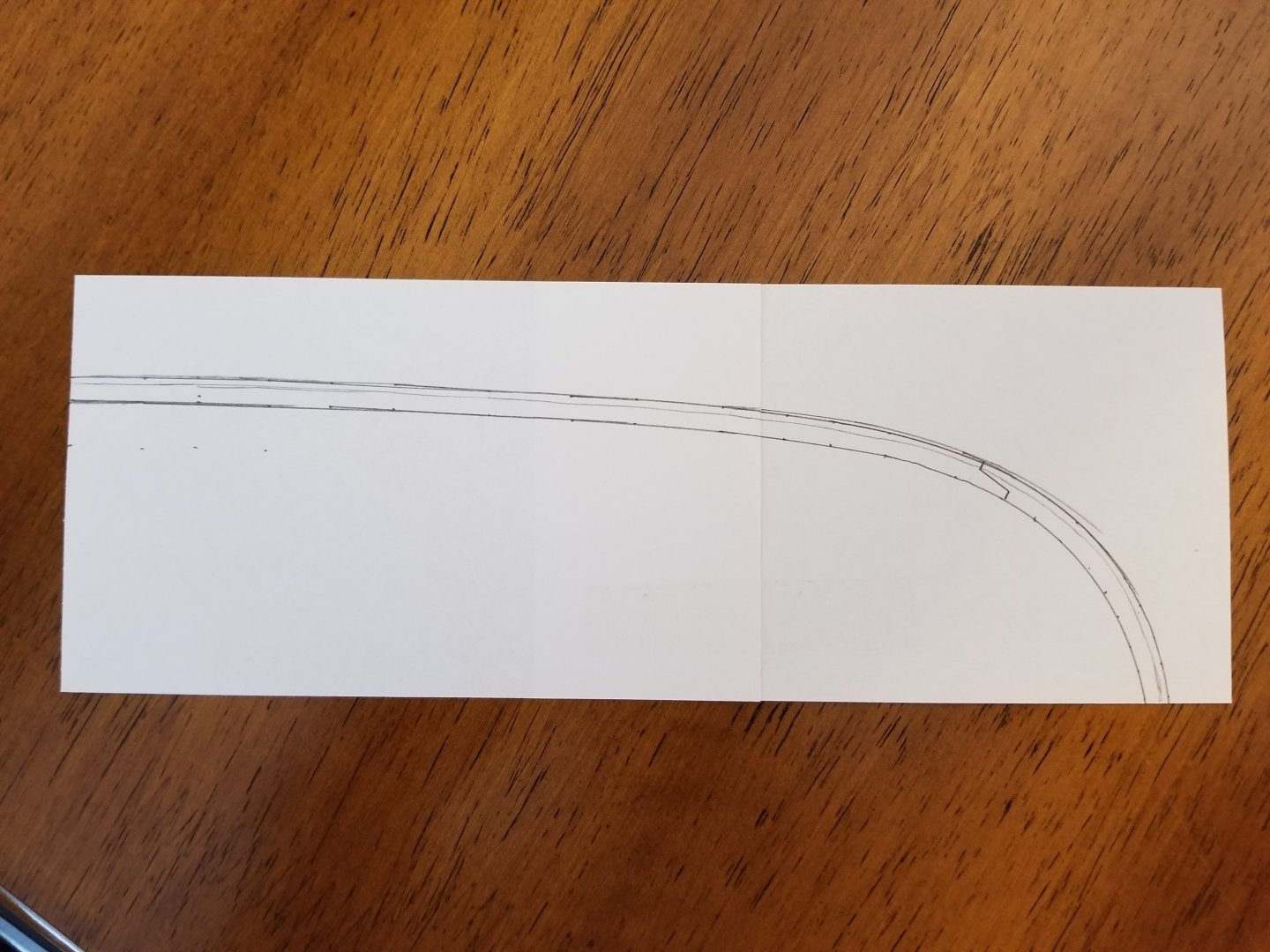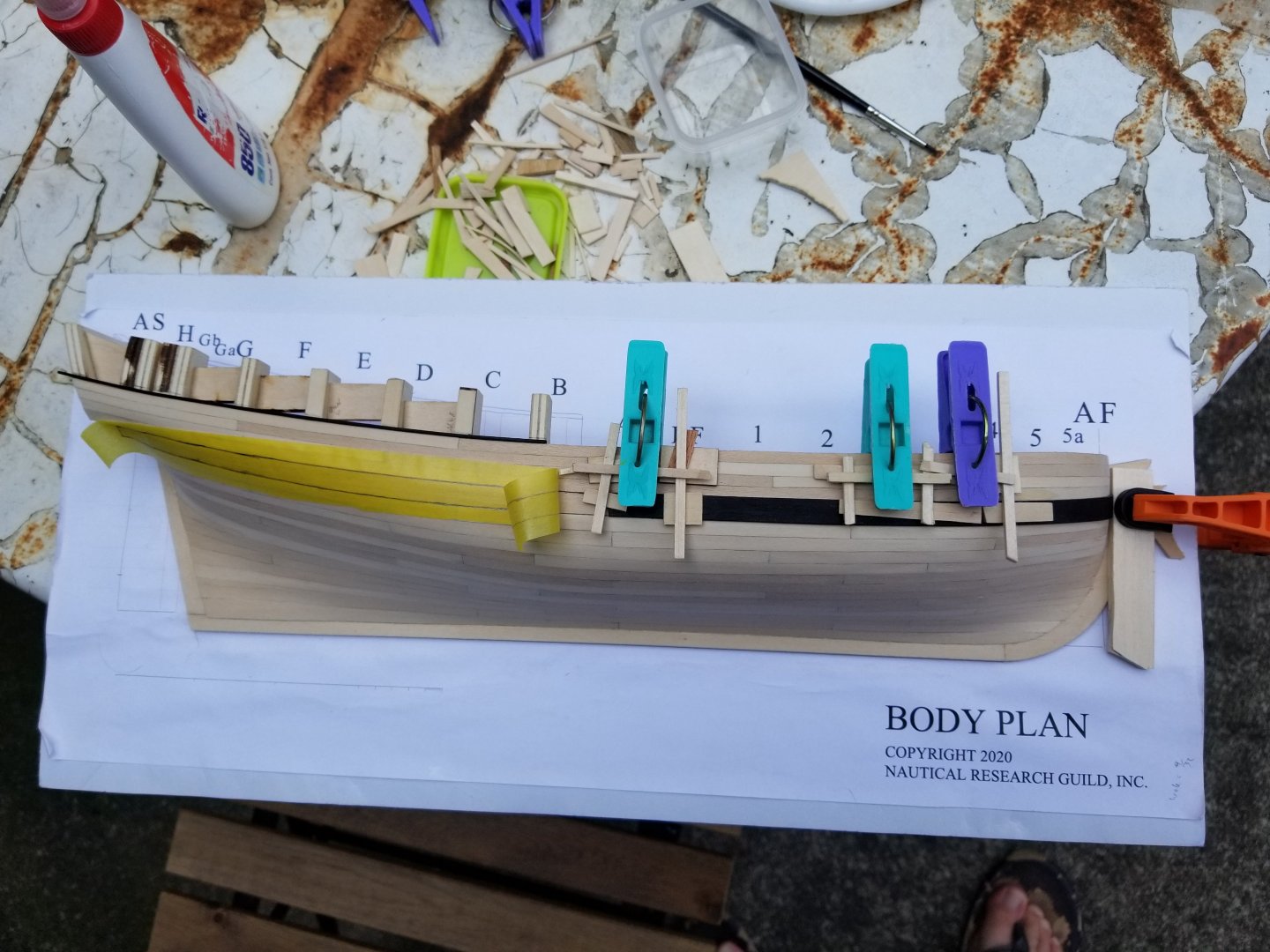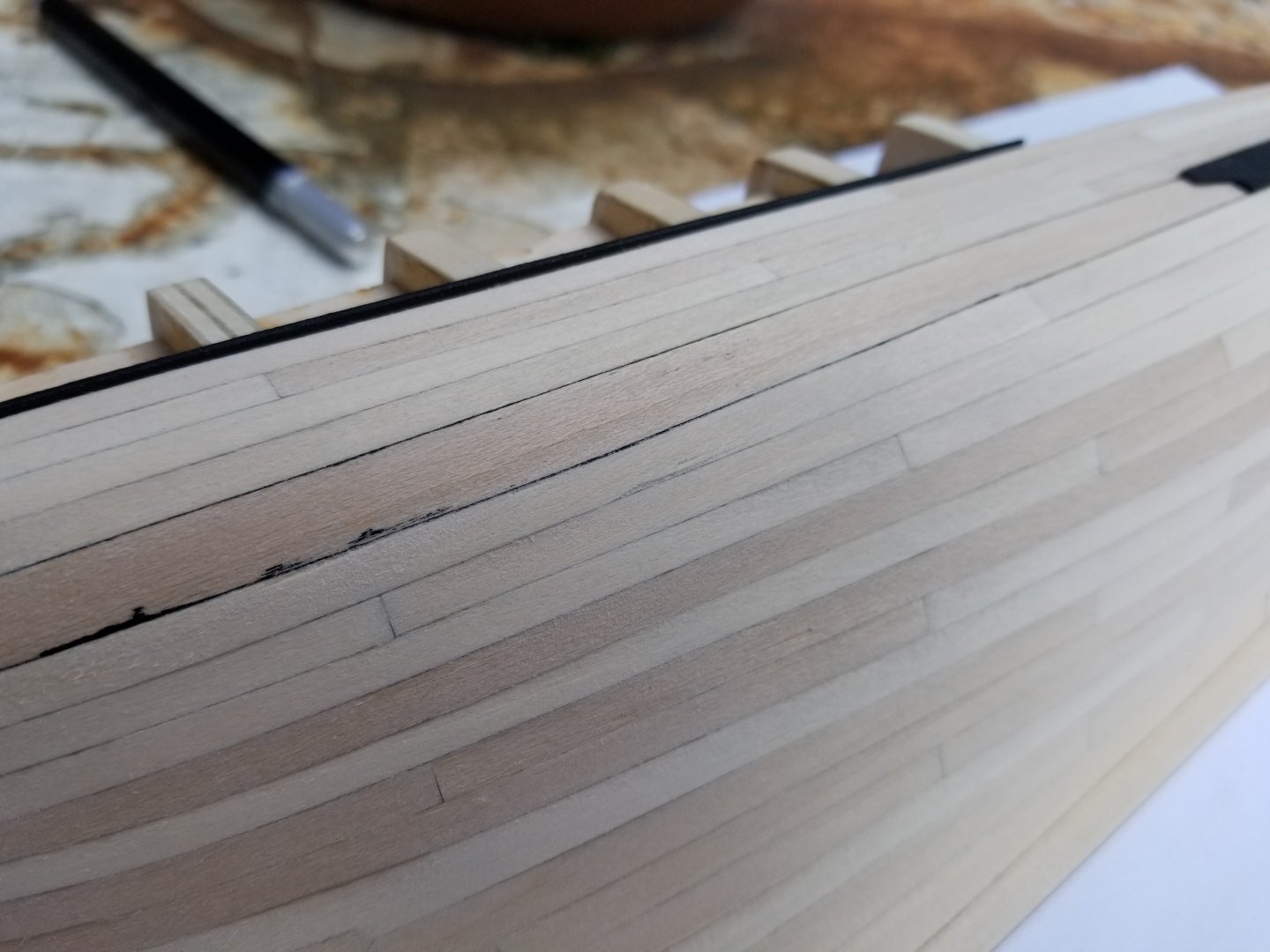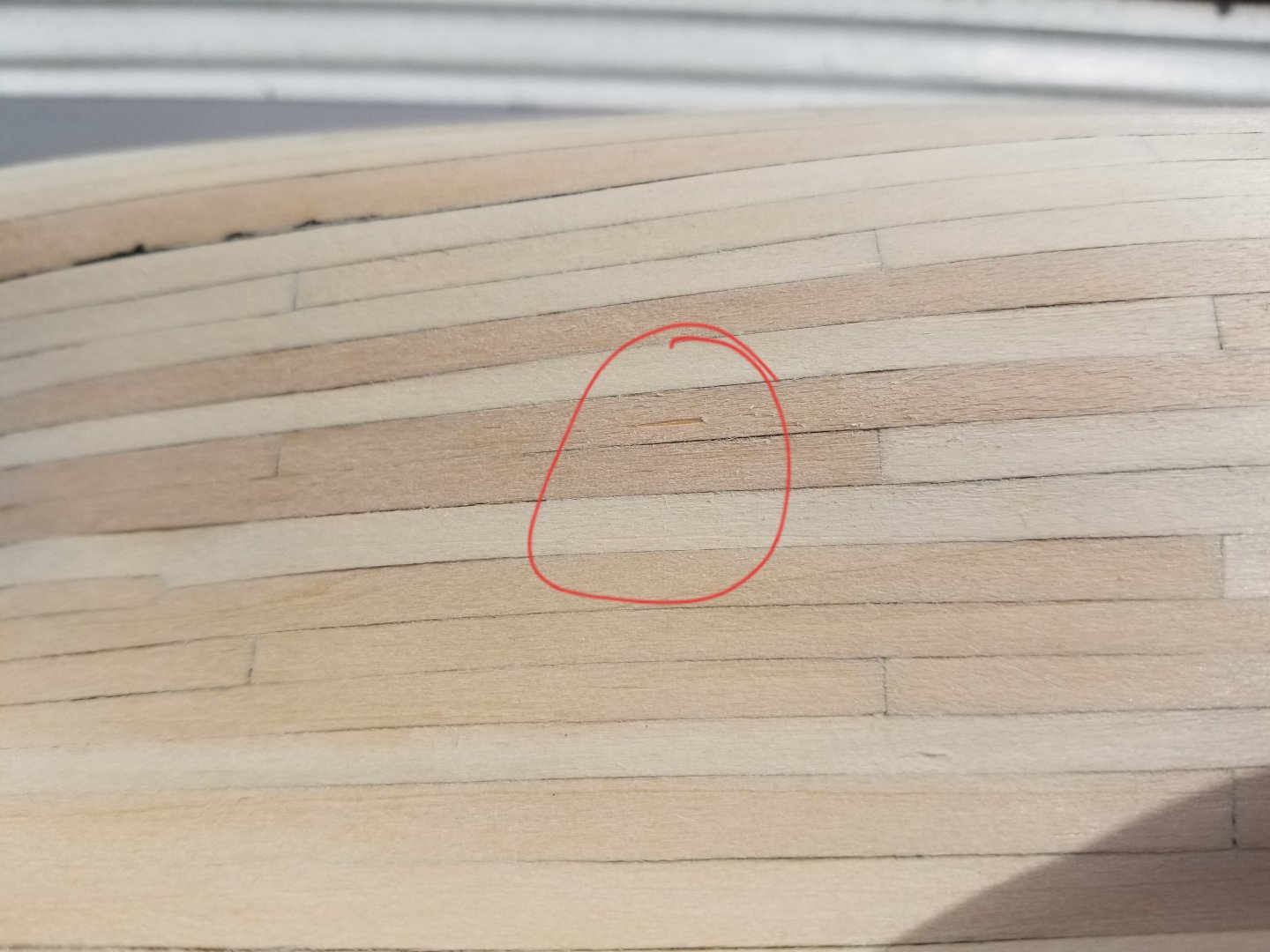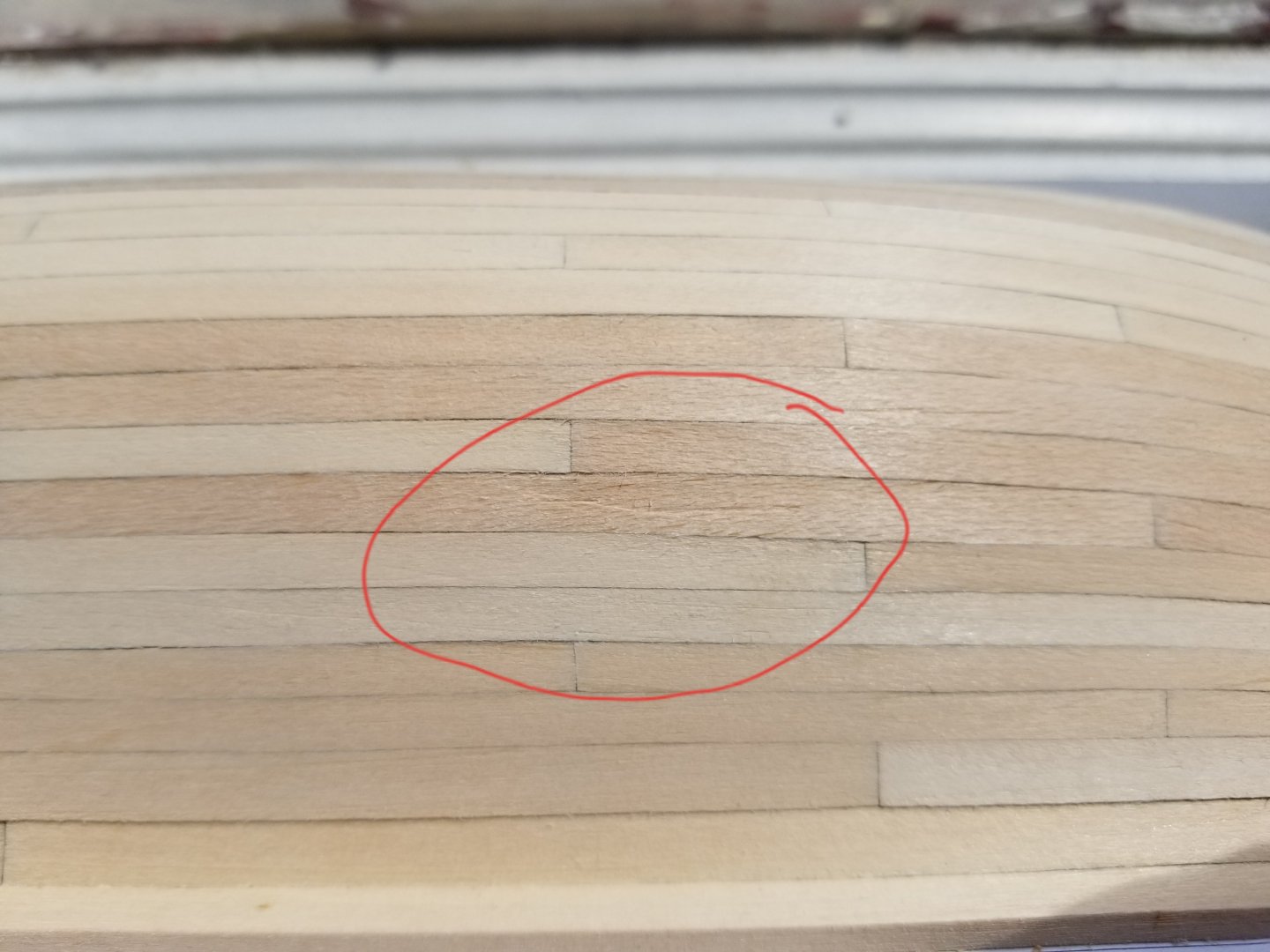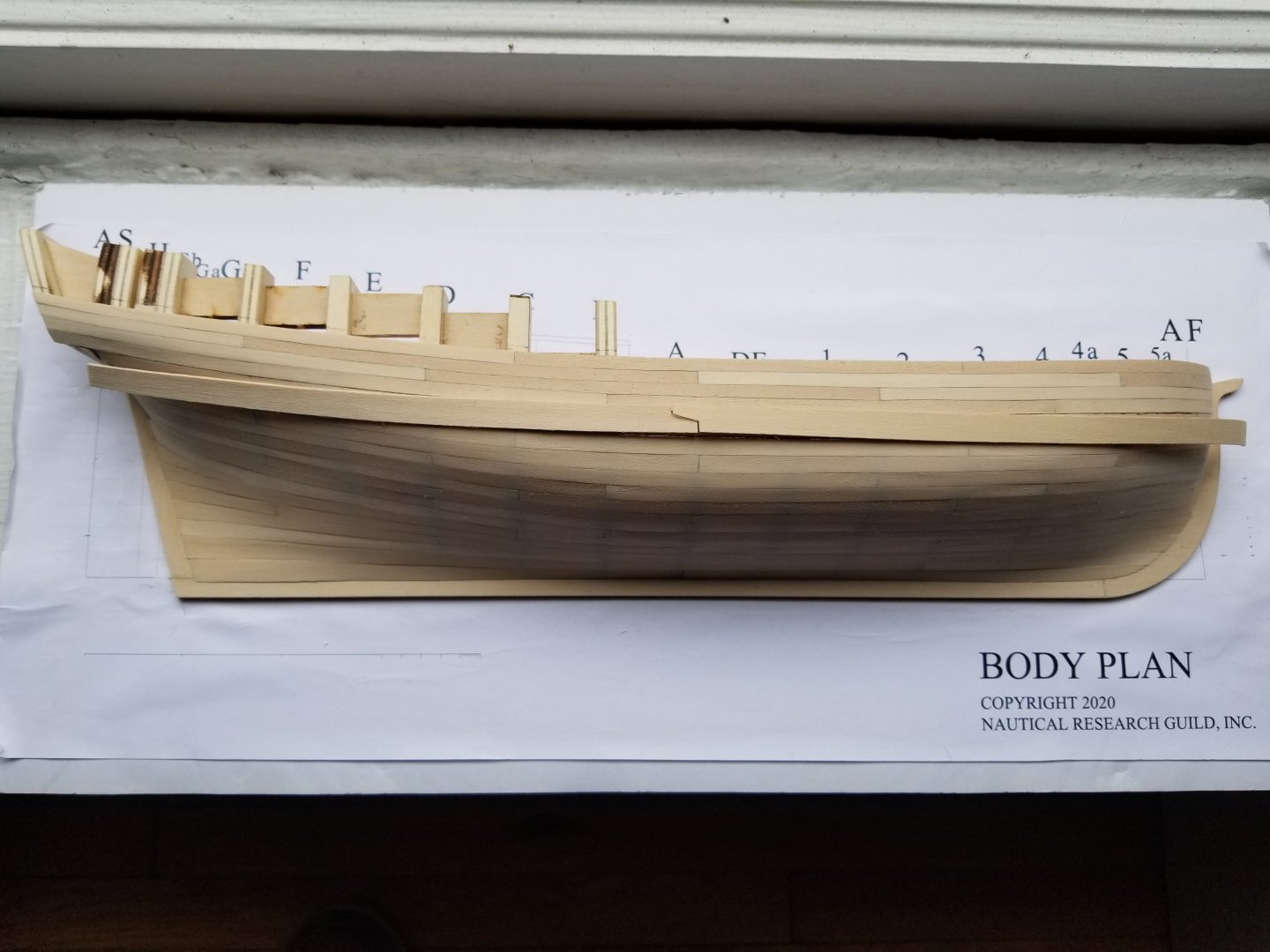-
Posts
1,309 -
Joined
-
Last visited
Content Type
Profiles
Forums
Gallery
Events
Everything posted by JacquesCousteau
-
Thanks! I may have to try using overhand knots, it sounds like a useful solution to the tension problem. While I wait to pick up some pva, I turned my attention to the rudder hinges. As shown in earlier posts, I had already made them and blackened them, and had decided that making them out of several pieces would be easier than trying to bend a series of tight 90-degree angles into the brass strip. So, the first step was to drill small slots alongside the sternpost and slot in the central hinge parts (the gudgeons), as seen below: Unfortunately, the top gudgeon has a small blotch portside that didn't properly blacken, which I didn't notice earlier. I'll need to do a bit of touch-up when I get more brass black, as my bottle didn't survive the move, but for now that side can go against the wall. Next, I added the fake hinge "arms" coming off of the sides. I still haven't found my tweezers, which got packed.... somewhere, so this was a bit tricky to do. As can be seen, there was a little smearing of super glue which I'll cover once I've bought paints again (another victim of the move, I got rid of them as they were drying up anyway). Although there's a bit of a visible line between the central hinge and the false arms, I don't think it's very noticeable and I'm mostly happy with how this part turned out. Next, the rudder side of the equation. After measuring, I drilled a couple holes into the rudder's front end and added in a couple pieces of black wire bent at a 90-degree angle to form the pintle. The rudder straps were then glued around it. Getting everything just right was a challenge, and after getting everything in place, it turns out there was a small gap--the upper strap was just a hair too high. I decided that I can live with it, though. In any case, the rudder hangs and can swing freely. Overall, I'm pleased with how the rudder turned out. I think the model looks much more balanced now: There are a few things to note, though. Overall, I found metalwork for the hinges to be a serious challenge and an often frustrating experience, with some effects on the build/build experience. First, I didn't get the gudgeons as small or as close to the hull as I would have liked, so there's a bit more of a gap between hull and rudder than I would have liked. This is largely due to the difficulties I had with bending brass. If I do hinges like this again, I will try to do a simpler false gudgeon that will be tighter against the hull by just making a simple loop similar to what I did for the pintle straps. Second, while the brass blackening mostly went well, upon handling the parts, I realized that I hadn't fully cleaned them and there was a bit of black powder that got on my hands. This is a highly toxic selenium compound. While I was able to remove it with thorough hand-washing, and thoroughly cleaned my desk afterward, I really don't like the idea of risking selenium poisoning. It's one thing to have a bottle of something toxic, but it's another thing to have a toxic powder that can more easily spread to places it shouldn't be. So, while I quite like the gunmetal color that the blackening process produced, I'm considering just going with paint in the future. Given that I don't love metalworking, too, I also might give a look at Chuck Passaro's boxwood hinge kits for future hinges.
- 286 replies
-
Having completed my move back to Mexico, I'm finally ready to return to work on the canoa! Back in June, in post number 183, I documented my first attempt at making and serving (or seizing? I have to admit that I'm confused by the difference between these terms) an eye splice on the top of the backstay. It didn't turn out very well for a number of reasons--I couldn't get a false splice so I just glued the rope, I used thread that was much too thick and fuzzy for the serving, and the end result was bulky and lumpy. Now that I'm more settled in, I decided to try again. This time, I was able to successfully do a false splice! I don't yet have a hypodermic needle, as Wefalck suggested, but I was able to separate the rope strands as follows. First, I placed the part of the rope that will form the loop in the clip of a helping hands. Then, holding the rope close to the clip, I rolled it to slightly unwind the strands in that spot only. Note: I'm using Ropes of Scale rope, which is treated to prevent unwinding--using an untreated rope could possibly lead to a catastrophic unwinding. I then passed the end through and re-rolled the rope. Success! I then immediately screwed things up on the next step. After placing it around the mast to ensure it was the right size, I used a bit of superglue to secure the splice. In doing so, I committed two errors. First, as I read immediately afterward, superglue is not recommended for rigging as it can maje the lines fragile and lead to breakage later--diluted white glue is better. Given that I'll probably need to unrig this model for another move in a year or two (I may have chosen the wrong hobby for my career, or vice versa), I definitely don't want to make it fragile. Second, I didn't properly trim it tight up against the splice, but (based on what I've seen in cases like the Model Shipways Norwegian Sailing Pram) left it a bit long and glued up against the stay, as seen below, to be lashed later. My error was especially clear when I double-checked photos. Although I don't have any photos that provide a very clear image of how they handled the loop at the top of the backstay on actual canoas, the splices or knots do appear to have been pretty compact, as seen in the image below--the ropes definitely aren't "doubled" as I did it. The perils of modeling before the coffee kicks in! Source: https://www.mexicoenfotos.com/antiguas/jalisco/chapala/un-velero-panorama-MX14561525002424 So, this morning was a good reminder to double-check what I'm doing before I do it! In any case, as I'm going to redo it, I decided to use this as a learning experience/testbed to try lashings and serving with different sizes and colors of fly-tying thread. For the lashings, which I used to practice clove hitches, I used 140 denier tan thread. As can be seen below, this practically disappeared against the rope. I used a darker brown 210 denier thread for the serving. I found it difficult to maintain even tension while serving. I really ought to get my old fly-tying equipment for it. In any case, as can be seen below by the contrast between the earlier attempt (above) and this try (below), the different materials and techniques made a big difference, and I think I should be able to do a better job on the final version.
- 286 replies
-
Welcome!
-
You may have better luck with a response if you can post a photo so people can have a better sense of what you're looking for. Also, you might try looking online for plans. If it's a British vessel, there are a lot of plans available at the Royal Museums Greenwich online collections (https://www.rmg.co.uk/collections/search/Pinnace) and many plans have been digitized and are available on Wikimedia.
-
Somehow I missed this log earlier, but I'm looking forward to following along. This build looks fantastic so far! And I definitely understand the difficulties of making model-building work without much space or a dedicated workshop. A fully framed model of a relatively small vessel at this scale looks challenging--out of curiosity, what thickness of wood did you use for frames?
-
Looks like you're off to a great start! I'm looking forward to following along, I haven't seen a log for this kit yet and was curious about how it compares with the Model Shipways version. These small fishing boats in a large scale leave a lot of room for creativity and personalization through kitbashing.
- 56 replies
-
- grand banks dory
- Midwest Products
-
(and 2 more)
Tagged with:
-
Thank you, @Knocklouder, @Oboship, @robert952, @Jorge Acevedo, and others for the kind comments and likes! No build progress just yet, but I am quite happy to report that the model survived the move to Mexico City. Given that space was at a premium--hard to pack everything accumulated over a decade of living somewhere into a few suitcases!--I trimmed the build board, leaving just enough to protect the hull. The interior was then stuffed with cloth placemats, and the hull was well-wrapped with layers of bubble wrap and cloth napkins. I especially built up some layers just ahead of the quarterdeck, as it seemed to be the point most likely to break. In hindsight, it probably would have been sturdier to add an extra layer of cardboard to further protect the hull, but the model survived the move intact in a hardshell suitcase, with a blanket stuffed around it (and other fragile items) to further cushion it. I have to say, the hull is much easier to pack than a fully rigged model. Given that I likely have more moves in my future, but would very much liks to build some rigged sailing vessels, I'm considering seeing if there's any way to build them such that the mast and rigging can be removed relatively painlessly for packing. In any case, I'm now considering how to make the display board. We have a nice miniature Tecuani mask that came magnetically attached to a black backboard with wood trim. I'm thinking that something similar might look good for the half hull. The hull might disappear against a wood-colored background, so I think a black background will focus attention on the hull, but the trim is a nice touch, and a magnet mounting so the hull can be removed would probably make things easier to pack. But we'll see.
- 82 replies
-
- half hull planking project
- half hull
-
(and 2 more)
Tagged with:
-
Very well done, congratulations!
- 51 replies
-
- Model Shipways
- Benjamin W Latham
-
(and 1 more)
Tagged with:
-
Very ambitious, I'm looking forward to following along! This sounds like a great way to contribute to the educational mission.
- 174 replies
-
- Vigilance
- Sailing Trawler
-
(and 1 more)
Tagged with:
-
Looks great! The stringers really highlight the lines of the hull. I forget if you may have said this earlier, but will you be leaving some of the planking off the finished build to show off the framing?
- 174 replies
-
- Vigilance
- Sailing Trawler
-
(and 1 more)
Tagged with:
-
Congratulations on a job well done!
- 19 replies
-
- mississippi riverboat
- Mini Mamoli
-
(and 2 more)
Tagged with:
-
Very cool! I recognize the top plan as from Chapelle, where do the other plans come from?
- 38 replies
-
- Chesapeake Bay Flattie
- Model Shipways
-
(and 2 more)
Tagged with:
-
Looks like you've done a great job, including overcoming some obstacles in the build.
- 38 replies
-
- Chesapeake Bay Flattie
- Model Shipways
-
(and 2 more)
Tagged with:
-
Congratulations! The completed model really looks great, you did an excellent job on it (tricky parts and all).
-
Excellent job! I particularly like the coloration on the floor planking, the tinted wipe-on poly really effectively gives it a slightly weathered look.
- 201 replies
-
- Oyster Sharpie
- first scratch build
-
(and 1 more)
Tagged with:
-
Very well done, quite the inventive display!
- 235 replies
-
- Banshee II
- Bottle
-
(and 1 more)
Tagged with:
-
Thanks! I've officially completed the hull! I'll still be finishing the hull and making the display board, so I'll hold off for now on marking this log as "finished," though. Adding the quarterdeck planking was pretty straightforward. While the instructions say that it should have three strakes, that seemed to lead to relatively wide planks, so I followed the lead of a number of other build logs and went with four instead. As can be seen, I left the ends of the planks long so I could properly size them afterward. I used a razor saw to cut off the ends. Planking the transom was pretty straightforward. The instructions say something about it being curved, but mine ended up pretty straight. I probably over-sanded the top of the transom way back at the start of the build, which would be a problem if I were trying to replicate a specific vessel, but it greatly simplified finishing the transom. Adding the rail to the quarterdeck and transom, as well as the stern trim, was very straightforward. I should note that I added a small support beam at the front of the quarterdeck planking. After the photo below, I added a shim on the front end so that I had more surface area to glue the rail piece that covers the front of the quarterdeck. One last part to add! As can be seen, I pre-curved the piece of stern trim before painting it. After I glued it in place and trimmed, I just had a little sanding and painting to do, and with that, the hull was complete! Overall, I'm pretty happy with how this turned out. There are a few things that I could definitely improve. This lighting really highlights how some of the hull planking ended up a little uneven, for instance. That said, this was my first curved hull to plank, and I generally like how it turned out. I'll write a more complete reflection on the kit later, but I feel it successfully taught me vital skills and has given me the confidence to tackle more complex models than the flat-bottomed vessels I've mostly been building so far. Next up, I'll be trimming the building board closer in size to the hull, wrapping everything in bubble wrap, boxing it, and moving with it back to Mexico City. Once there in September, I'll be applying some sort of oil or wipe-on poly to the hull, and mounting it to some sort of display board.
- 82 replies
-
- half hull planking project
- half hull
-
(and 2 more)
Tagged with:
-
Nice job, the captsan looks much better and well done with the brass!
- 86 replies
-
- San Francisco
- Artesania Latina
-
(and 2 more)
Tagged with:
-
Thanks! I'll definitely test with the tape before marking anything out. In any case, I was able to shape the aft wale. Clamping it to dry to the curve was tricky and I had to get creative with a rubber band at the aft end. I then painted the wale, sanding it smooth between layers of paint. Test fit below: Clamping the foreward end in place was simple enough, but the aft end was tricky. The lower layer of the wale hadn't been quite long enough, so I had ended up needing to fill a slight hollow there. I used a dab of super glue at the end, which unfortunately slightly marred the finish of the hull but I think I was able to lightly sand it out. The photo also shows the counter planking. As can be seen, I mis-judged the widths so they're a bit uneven, although I don't think it will be very noticeable once the stern trim is in place. Next, I made and painted the rail. I did not glue it together off-model as I was worried about getting the angle slightly wrong. Instead, I glued the main piece in place first, then the fore end. Once again, clamping was necessary to hold everything in place, although due to a lack of places to put the clamps at the bow, I just held it in place by hand until the glue set. Despite a few setbacks, I'm very happy with how this is turning out:
- 82 replies
-
- half hull planking project
- half hull
-
(and 2 more)
Tagged with:
-
Incredibly, it happened again (although not as much of a gouge) when I pulled the tape off the new aft wale! I'm trying to think of what could be causing this and I'm very confused. Is this just because it's been hot and humid in Chicago lately? If that's the cause, then I don't think I'll be able to finish until after I move to (drier, cooler) Mexico City. If anyone has seen this before or has an idea of what's causing it, I'd love to hear.
- 82 replies
-
- half hull planking project
- half hull
-
(and 2 more)
Tagged with:
-
One step forward, one step back. First, I marked out the size and shape of the rail, going a little wider than suggested in the instructions. Next, I glued on the strip marking the quarterdeck. I also placed tape to again mark out the aft wale. I decided that it would be easiest to get a good scarf joint if one end was pinned down, instead of having both parts of the wale free-floating, so I glued the fore part of the wale in place. I have to say, the black wale against the natural wood looks very sharp. Once it dried, I placed the tape over the end to mark the scarf. Unfortunately, the stringiness that I noted above in some of the hull planking caused a serious problem. Although I'm using Tamiya masking tape, which is supposed to be not very sticky, it pulled a couple "strings" in the wood out with it, leaving very noticeable gouges in the hull! This is definitely a bit frustrating. I'm not sure why this is happening, this seems very unusual. I was able to somewhat smooth it by sanding, at least, but I'm concerned about accidentally pulling out more "strings" from the hull.
- 82 replies
-
- half hull planking project
- half hull
-
(and 2 more)
Tagged with:
-
Very nicely done! You may want to consider sanding the frame head iron down a little so it's thinner to be more in scale. On my build, I used an index card to make the irons.
- 5 replies
-
- Lowell Grand Banks Dory
- Model Shipways
-
(and 1 more)
Tagged with:
-
Thanks! Next up, I made a 1/16x1/32-inch strip and painted it black to serve as the quarterdeck trim. This was very basic to do, so I didn't think to take photos. I haven't installed it yet, though, as I wanted to fully smooth the hull first. This was a bit challenging, given basswood's propensity to form a fuzzy surface. Part of my solution was to brush on watered-down white glue on the interior, which stuck the planks to each other between the frames and allowed for much more even sanding. Following Toni Levine's suggestion in her build log, I went up to 1500 grit, wet-sanding the hull with the finest grits. The results were mixed. On one hand, it did indeed get the hull quite smooth, which is nice. On the other hand, one of the basswood sheets was grainier than the others, and in several spots the sanding pulled up a "string" in the wood, leaving a small gouge. This can be seen in the photos below: I'm not sure why this piece of basswood looks so different from the others and sands so differently. I do not think I will be sanding the hull any further, as I don't want to cause any further gouges, and the 1/32‐inch planking is quite thin. I also began work on the wale, drawing a simple scarf joint onbthe first layer. Cutting the scarf was tricky and required some shaping to get a nice joint. However, when I finally got the pieces shown below to match up (note: they aren't glued, just resting on the curved hull, hence why they look off), I found that the aft wale section was now too short. So, I'll be remaking the aft wale piece and leaving it long, so that shaping the scarf doesn't leave it too short.
- 82 replies
-
- half hull planking project
- half hull
-
(and 2 more)
Tagged with:
About us
Modelshipworld - Advancing Ship Modeling through Research
SSL Secured
Your security is important for us so this Website is SSL-Secured
NRG Mailing Address
Nautical Research Guild
237 South Lincoln Street
Westmont IL, 60559-1917
Model Ship World ® and the MSW logo are Registered Trademarks, and belong to the Nautical Research Guild (United States Patent and Trademark Office: No. 6,929,264 & No. 6,929,274, registered Dec. 20, 2022)
Helpful Links
About the NRG
If you enjoy building ship models that are historically accurate as well as beautiful, then The Nautical Research Guild (NRG) is just right for you.
The Guild is a non-profit educational organization whose mission is to “Advance Ship Modeling Through Research”. We provide support to our members in their efforts to raise the quality of their model ships.
The Nautical Research Guild has published our world-renowned quarterly magazine, The Nautical Research Journal, since 1955. The pages of the Journal are full of articles by accomplished ship modelers who show you how they create those exquisite details on their models, and by maritime historians who show you the correct details to build. The Journal is available in both print and digital editions. Go to the NRG web site (www.thenrg.org) to download a complimentary digital copy of the Journal. The NRG also publishes plan sets, books and compilations of back issues of the Journal and the former Ships in Scale and Model Ship Builder magazines.



